|
|
 |
Canadian Historic Sites: Occasional Papers in Archaeology and History No. 19
Yukon Transportation: A History
by Gordon Bennett
The Great Stampede
I
On 16 August 1896 gold was discovered on Bonanza Creek, a tiny
tributary of the Klondike River. As news of the discovery spread
throughout the territory, prospector after prospector, miner after miner
abandoned his diggings and set off in frenzied pursuit of the new El
Dorado. A year later Klondike hysteria enveloped the outside world.
In many respects the Klondike discovery and the stampede it fathered
provided a fitting curtain to the 19th century. Debilitating depression
with only brief and fitful interruptions had overhung the western world
for a generation before 1898. The psychological effects of the Klondike
discovery changed all this, precipitating an almost New Year's Eve type
of celebration of purge and promise, as the worn-out 19th century
indulged in one last grand binge. In an era that had been characterized
by the Gilded Age, the Great Barbecue and the Robber Barons, the chain
of events set in motion by the discovery served to democratize the maxim
that "money making was the most prized career."1 No longer
was wealth regarded as a private prerogative of a Rockefeller, a Morgan
or a Carnegie: the New Year's resolution on everyone's mind was to
strike it rich.
With unwitting foresight, a despatch datelined Forty Mile, Yukon
Territory, 17 August 1896, predicted that "such is the lure of gold in
depression ridden America that many are expected to come."2 Probably
no other event in Yukon history has ever been anticipated with such
understatement. From late July of 1897 when the Portland and the
Excelsior, each laden with gold, landed in Seattle and San
Francisco respectively, most of the English-speaking world and much of
Europe found itself caught up in a maelstrom that knew only two words
— "gold" and Klondike. Almost immediately a crush of humanity,
doggedly determined to win its fair share of untold wealth, streamed
north. Three factors made the Klondike gold rush possible: the existence
of a vast amount of placer gold, the publicity given to the
discovery in the press of the time, and the transportation system that
had evolved since the era of the fur trade.3 Without a
juxtaposition of the three in 1897-98 the gold rush would never
have reached the proportions that it did.
If one accepts the definition of transportation in its broadest sense
as the utilization of transportation routes and a variety of
transportation forms to move men and supplies, the history of
transportation during the gold rush can be said to have been practically
synonymous with the history of the gold rush itself. Each interacted
with the other; the one as cause, the other as effect as circumstances
dictated. If the gold rush is conceived, moreover, not as an independent
entity nor as a temporary aberration, but as one stage in the
historical evolution of the Yukon, then an estimate of its effect on the
transportation system can be attempted. With the exception of the
railroad, the impact of which properly belongs to a future chapter, the
gold rush did not substantively alter the nature or function of the
gateways which had been established prior to 1896. No new routes of any
consequence were discovered although several variations on the old
routes were used with varying degrees of success. What the gold rush did
do was to exaggerate the impracticality of the old Hudson's Bay Company
fur-trade routes and to strain and emphasize the inadequacy of the
coastal routes under gold-rush conditions. Where the effects of the gold
rush were most clearly felt were on the modes of transportation. As
might be expected, many of these effects were quantitative, but the
building of roads and tramways, the introduction of sternwheelers on the
upper river, and the construction of the White Pass and Yukon Route
railway were major qualitative changes in the transportation system of
the Yukon.
II
Another qualitative change which is not so immediately apparent also
occurred. Before 1896, no government had attempted to influence or
interfere with the transportation system. Adjustments in the
transportation system had resulted from the action of natural forces and
the response to them by individual men or trading companies. As we have
seen, this process of "natural selection" had resulted in the practical
extinction of the Hudson's Bay Company fur-trade routes, the domination
of trade by the Saint Michael route and the rise of the Chilkoot route
as the principal avenue of migration. With the gold rush, however,
government for the first time became actively interested in influencing
the flow of transportation into the Canadian North. The most conspicuous
examples of this interference were the promotion of the old Hudson's Bay
Company trade routes by the municipality of Edmonton; the promotion of
the Stikine railway project by the dominion government, and the
imposition of customs duties.
When news of the gold strike on Bonanza Creek reached the outside,
Edmonton was only a small town of seven hundred people. Nonetheless,
Edmonton qualified as a transfer point to the Klondike, being situated
at the head of a known trail to the Yukon (the old Hudson's Bay Company
Athabasca-Mackenzie-Porcupine-Yukon river route) and having the
facilities to serve as a supply base, in this instance the northern
terminus of the Canadian Pacific Railway.4 In an attempt to
stimulate the economy, local politicians and merchants undertook an
advertising campaign to attract stampeders. Billing the route through
Edmonton as the "All Canadian Route,"5 they hoped to
capitalize on the patriotic inclinations of the Canadian stampeders. On
a more practical plane, the promoters emphasized the fact that "going
via Edmonton" eliminated customs levies, an important consideration for
those who had mortgaged themselves in order to take part in the rush.
Had Edmonton advocates been content to stand on this one advantage, the
Edmonton route would most likely have escaped the notoriety for which it
was later known, but the city built its advertising campaign around the
dubious assertion that the Edmonton trail was the fastest route to the
gold fields. Even the most ardent optimist would have been hard-pressed
to substantiate this claim for the truth of the matter was that the 90
days allowed for traversing the trail by the Edmonton promoters was
patently unrealistic.6 That some people took this route is
indicative of the delirium that overcame normally sane men during the
gold rush. The Hudson's Bay Company presence in the Yukon had always
been precarious, with transportation a basic problem. This obstacle, as
we have seen, was never successfully overcome. Moreover, to exacerbate
the plight of those who chose this route during the gold rush, the light
canoes, the assistance of Indians and voyageurs, the series of supply
bases, all of which had been available to the fur trader, were not
available to the gold seekers. Nor was there any resemblance between
traders who were capable of withstanding the rigours of the trail and
the stampeders who were not.
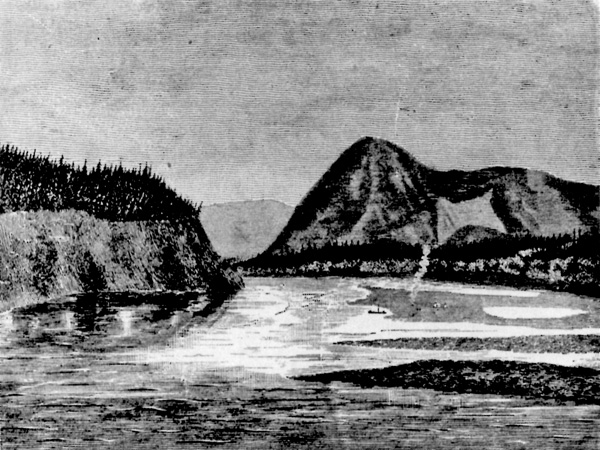
22 The first known view of what later became Dawson City — 13 years
before the discovery of gold on Bonanza Creek.
(Frederick Schwatka, Along Alaska's Great
River [New York: Cassell & Company (1885), p. 243.)
|
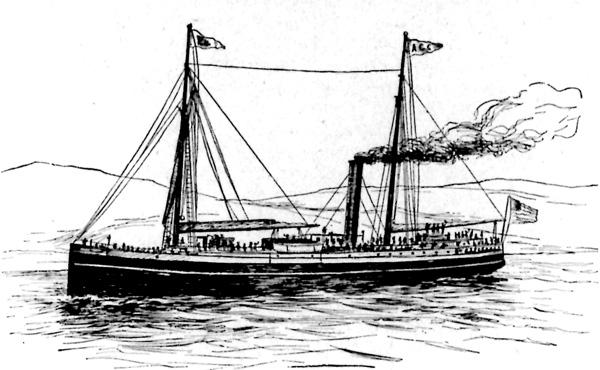
23 The arrival of the Excelsior (below) in San Francisco and the
Portland in Seattle in July 1897 signalled the beginning of the
great stampede.
(Chicago Record, Klondike [Chicago: Chicago Record
Co., 1897], p. 400.)
|

24 The Stikine route and main Edmonton trails to the Klondike.
(Map by S. Epps.) (click on image for a PDF version)
|
Of the one hundred thousand people who set out for the Klondike in
1897-98, only two thousand used the Edmonton route. Few of those
who did ever reached their destination. "Not a single one," Pierre
Berton has written, "as far as can be determined, found any gold at
all."7 In almost every case it took two years to go from
Edmonton to Dawson and by the time the lucky ones finally made it, the
gold fields had been staked from end to end. This first example of an
attempt by government, in this case municipal, to influence the
direction of transportation flow into the Yukon would have been comic
had it not had such tragic consequences. The overland routes running
west of the Mackenzie River proved no more responsive to the wishes of
Edmonton than they had been to those of the Hudson's Bay Company.
Edmonton was not the only would-be metropolis to vie for the Klondike
trade. Operating on the valid assumption that the great majority of
stampeders would opt for one of the coastal routes, the port cities of
Victoria and Vancouver, with the active support of Montreal- and
Toronto-based railroad interests, set out to supply the outfitting and
transportation needs created by the rush. In
this they were assisted by the Canadian government which imposed a
schedule of customs duties on all foreign goods going into the Yukon.
This schedule had the dual purpose of raising revenues and diverting
business away from such American centres as Seattle and San Francisco
which had early established a stranglehold on Klondike trade. As the
Yukon was cut off from the coast by the Alaska Panhandle, however, all
goods had to pass through American territory before reaching the Yukon.
There, supplies that had been purchased in Canada were liable to
retaliatory customs duties levied by American authorities, unless conveyed
through Alaska in bond, in which case any prior advantage gained from
outfitting in Canada was lost.
The trade issue was complicated by a longstanding dispute with the
United States over the Alaska boundary.8 Despite Canada's
claim that Dyea and Skagway, the coastal gateways to the Yukon interior,
were on Canadian soil, the United States exercised sovereignty over
both of them. Ever since the late 1880s Canada had pressed for a
solution to the question only to meet with American indifference. The
gold rush made a settlement all the more urgent from the Canadian
viewpoint for reasons of state as well as for the potential effect that
any settlement would have on the rivalry between Canadian and American
ports. The United States, on the other hand, showed little interest in
negotiating so long as it enjoyed de facto control over all supplies
going into the Klondike via the coastal routes.
An alternative solution to the boundary imbroglio presented itself
in the Stikine River route which originated at Fort Wrangell, Alaska,
followed the Stikine River to Telegraph Creek, crossed overland to
Teslin Lake on the British Columbia-Yukon border and thence down the
Yukon River system to Dawson.9 Under the treaty of 1825
between Great Britain and Russia, Great Britain had secured free
navigation rights on the Stikine which were ceded to Canada after
1867.10 The Stikine route, therefore, became a vital lever in Canada's
attempt to influence transportation flow into the Yukon, especially in
view of the failure to reach an accord with the United States on the
boundary question. The surveyor general of Canada succinctly explained
the need to develop the Stikine route. "We must have an independent
road allowing free access to our country whatever complications may
arise with the United States," he wrote, "and for this purpose it is
imperative that a road be located from Telegraph Creek to Teslin
Lake."11 With this in mind, the Canadian government signed a
contract on 26 January 1898 with those ubiquitous Canadian railroad
contractors, William Mackenzie and Donald Mann, to build a wagon road
within six weeks and a narrow-gauge railway by 1 September 1898 from the
head of navigation on the Stikine to
Teslin Lake.12 To complete the transportation system, the
government planned to connect each end of the rail line with a fleet of
steamboats.13 In return, Mackenzie and Mann were to receive a
land subsidy of 25,000 acres for each mile of line constructed. After a
long and occasionally acrimonious debate in the House of Commons, a bill
was passed approving the project.14 Twelve miles of track had
been laid and tickets had actually been sold when the
Conservative-dominated Senate rejected the terms of the government
contract. This dealt the coup de grâce to the Stikine project
and the railroad scheme was unceremoniously abandoned.15
Attempts to regulate artifically the flow of transportation into the
Yukon during the gold rush failed. Only in the imposition of customs
duties did the government achieve any partial success. This action may
have persuaded some to use the Edmonton route and it seems evident that
it was partly responsible for stimulating the trading and transportation
companies operating out of Victoria and Vancouver. The failure of
government to influence the selection of access routes to the Klondike,
however, appeared in sharp contrast to what was taking place, without
government intervention, on the traditional gateways of Saint Michael
and the Lynn Canal.
III
These two gateways, which attracted the majority of stampeders, were
linked to the West Coast outfitting ports by a thousand-mile stretch of
water known as the Inside Passage. As a result of the unprecedented
demand for coastal steamer facilities, the existing transportation
companies were strained to capacity.16 To cope with the
overflow, a number of new transportation companies sprang into
existence, coastal steamer production was rapidly increased, and old,
generally unseaworthy vessels that had been left to rot on the beaches
were revived, Martha Black, a towering figure in the post-Klondike
period of Yukon history, later described what for most of the stampeders
had been a typical trip up the coast when the gold-rush hysteria was at
its height.
The steamer was certainly a "has-been." She was dirty, and loaded
to the gun wales with passengers, animals, and freight. Men slept on the
floor of the saloon and in every corner. The captain was seldom, if
ever, sober, and there were many wild parties. Poker, blackjack, and
drinking went on night and day, and our safe arrival in Skagway was due
probably to the Guiding Hand that looks after children, tools, and
drunken men.17
The Saint Michael route responded to the gold-rush transportation
challenge with a rapid expansion in facilities. By the summer of 1898
there were an estimated 110 steamers on the lower river, a tenfold
increase over 1897 and a 14-fold increase over the pre-gold-rush
number.18 Saint Michael itself became something of a
boat-building or, more correctly, a boat-assembly centre.19
Yet despite the rapid increase in the number of boats on the lower
river, the Saint Michael route never did regain control of population
movement into the interior, a control it had lost to its Lynn Canal
rival after 1882. Though potentially the fastest route to the gold
fields, this advantage was never seized.
Several factors account for the lower route's failure to exploit the
opportunity provided by the gold rush. The transfer of traffic from
coastal steamer to river boat was not orderly. Passengers would be
spilled off the decks of the ocean vessels at Saint Michael only to
discover that there were no available sternwheelers to take them on the
last leg of the voyage to Dawson. This problem was exacerbated by
impediments to navigation on the lower river itself. On that section of
the river below Circle City known as "the flats," the river spread out
like a lake, cut through and through by innumerable bars and islands. As
a result, the river was reduced to little more than a series of small
shallow streams through which a pilot had to locate a channel
large enough to accommodate large steamers. Every summer once the
channel had been found, a pilot was stationed on the flats to take the
boats safely through, but the annual spring floods made it necessary to
locate a new channel each year.20 Initially the trading
companies had used Eskimos and Indians as deck hands and pilots because
of their knowledge of the river; however, their familiarity with the
watercourse was limited to short stretches and as a consequence 20 or
more native pilots were required for each trip. This system was
abandoned once white pilots had gained enough experience to navigate the
river without outside help, but the problem of shifting channels
remained.21
Another difficult section of the river was encountered at the
"Ramparts." At this point a sternwheeler running against the current
was forced to tie up every 10 or 15 minutes so that an extra head of
steam could be raised.22 At Fort Yukon, low water often made
it impossible to take a sternwheeler above the post.23 Had
the United States government acted upon the suggestion that a
permanent channel be dredged through the flats and at Fort
Yukon,24 the lower river might have attracted a great deal
more of the Klondike traffic than it did. However, while the lower river
route did not attract large numbers of stampeders, it did retain
important function that it had performed since 1869 as the life line to
the Yukon.25 Despite certain obstacles to navigation, it
remained the only feasible route over which heavy freight could be
brought in.26
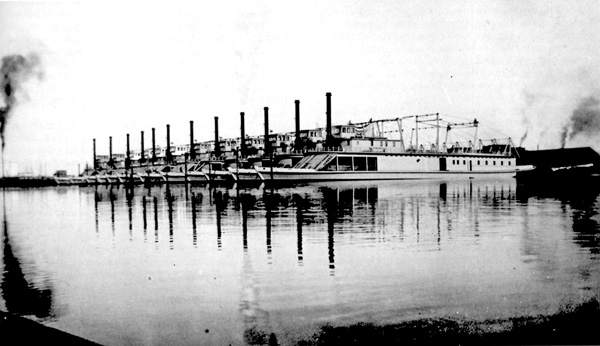
25 "Built by the mile and cut apart in proper lengths" — thus
did one observer describe the 12 virtually identical boats built by
the Moran Brothers shipyard in Seattle for the Klondike trade.
Included in this commercial armada were the J. P. Light, D. R.
Campbell, F. K. Gustin, Mary F. Graff, Pilgrim, Victoria, and
Oil City.
(Minnesota Historical Society.)
|
If most of the stampeders avoided the Edmonton trails and the Saint
Michael route with remarkable if unconscious discretion, they made up
for it by pouring onto the Alaska Panhandle with blitzkrieg force. It
was here that the mad cascade that constituted one of the largest mass
movements in peacetime history converged, only to be scattered upon one
of the six trails which led into the Yukon interior. Of these trails,
the most popular by far proved to be the trails over the Chilkoot and
White passes on Lynn Canal.27
Before the gold rush, the density of traffic over the Chilkoot Trail
had not been heavy enough to justify any major improvements.
Consequently, when the first wave of stampeders hit the beaches at Dyea
in August of 1897, the transportation facilities were wholly inadequate
to cope with the assault: a roughed-out road between Dyea and Sheep Camp
which required fording, a horse packing outfit that had been organized
in 1894 by John J. Healy28 and the human packing service
provided by the Indians. As a result, the stampeders were forced to
transport themselves and their supplies under the most adverse
circumstances. During late summer of 1897 many built canoes to move
their supplies up the Dyea River to the head of canoe navigation at
Canyon City, at which point everything was transferred to the trail
which led over the summit. When the river froze over, some sledded their
outfits over the ice to a point just below Sheep Camp.29 Most
of the stampeders, however, moved their supplies along the Dyea-Sheep
Camp trail that had been cut prior to the gold rush.
As the number of stampeders increased, some improvements became
necessary. A toll bridge was built one-half mile out of Dyea and a good
wagon road was constructed to Finnegan's Point, six miles outside the
city.30 Horses were brought into Dyea in great quantity and
packing operations were expanded. A number of communities sprang up
along the trail where the stampeders could stop for food and shelter,
only to disappear when the gold rush had spent itself and eliminated
their function.31
That winter the trail was improved when 150 steps were cut out of the
ice on the coastal side of the summit. Later more steps were added. A
cord life line was strung up parallel to this somewhat incongruous
stairway and shelves were hacked out at intervals so the stampeders
could avail themselves of a few moments' respite. A toll was levied for
the use of the steps which the operators collected without the
arguments commonly associated with such an enterprise. As T.A. Rickard
noted, "Everyone was in a hurry; and anything that facilitated progress
was liberally compensated."32 In December a horse-powered
tramway was constructed up the pass. It was superseded by a much more
ambitious undertaking in the spring of 1898. The new tramway,
which ferried goods from Canyon City to the summit and was later
extended to Crater Lake, was built by the Chilkoot Railroad and
Transportation Company. It consisted of a copper-steel cable supported
by tripods anchored in concrete and was powered by steam generators.
When it was finished, it was said to have "had the longest single span
in the world, twenty-two hundred feet from one support to the next."
Each car on the line had a 300-pound capacity. The tramway never
stopped and in the spring of 1898 it was dropping freight on the summit
at the rate of nine tons an hour.33
After the Chilkoot Railroad and Transportation Company tramway was
completed, the Dyea trail was equipped with a coherent transportation
system which eliminated most of the transportation problems that had
previously impeded the movement of traffic along this route. Freight
rates fell sharply, levelling off at 13 cents a pound for the through
journey between Dyea and Bennett;34 however, the impact of
this significant improvement was small. Ironically, by the time the
tramway became operable, the stream of humanity that had set out for the
Klondike the previous summer had practically dried up.
Since 1882 the Chilkoot Trail had been the funnel through which men
in search of Yukon gold had flowed. The gold rush did not change this. Of
the forty-odd thousand stampeders who are estimated to have made it into
the Klondike, well over half went in by this route.35 But
whereas before 1897-98 the Dyea trail had been regarded as the best
route to the Yukon gold fields, the gold rush had the effect of exaggerating
its deficiencies to the point where they overshadowed its utility.
Martha Black spoke for most of those who took the Chilkoot Trail during
the gold rush when she called it the "worst trail this side of hell."
"Men talked of the Chilkoot as if it were a malevolent thing," Kathryn
Winslow has written, "capable of wrath and punishment."36 Of all the
photographs taken of the gold rush, the one that depicted a black line
of lock-stepped humanity, stooped and bent as it inched its way through
the pass, came to symbolize this adversity.
Why did the gold rush so alter the reputation of the Chilkoot Trail?
Why did this transportation highway into the Yukon, heretofore regarded as the
best route into the interior, come to be regarded as some kind of hell
the stampeder had to survive before he was worthy of the Klondike
treasure? Was it the trail itself or something else that made men look
upon the Chilkoot as that "malevolent thing"? The evidence suggests that
a combination of factors, the stampeders themselves, the size of the
stampede, the season, as well as the inadequacies of the trail, wrought the
change. Few of those who set out for the Klondike in the fall of 1897
were fit enough to cope with the rigours of the trail. Fewer
still had any alpine experience. Improper diet and inappropriate
clothing for both the task and the climate added to the
hardship,37 but of all the burdens that each stampeder had to
face before he reached the Klondike, none was more significant in
altering the reputation of the trail than packing.

26 The Chilkoot and White Pass trails.
(Map by S. Epps.) (click on image for a PDF version)
|

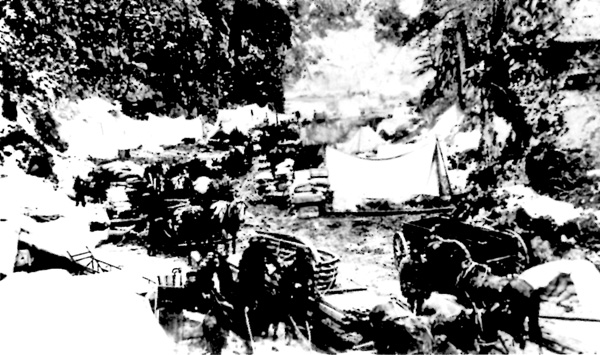
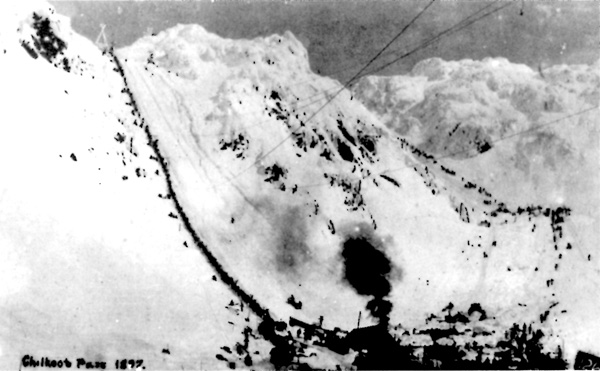
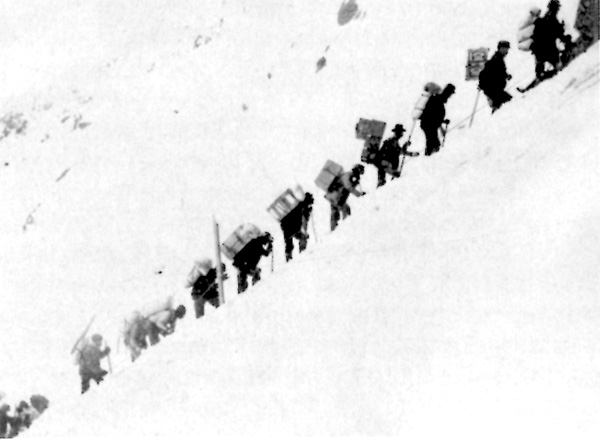
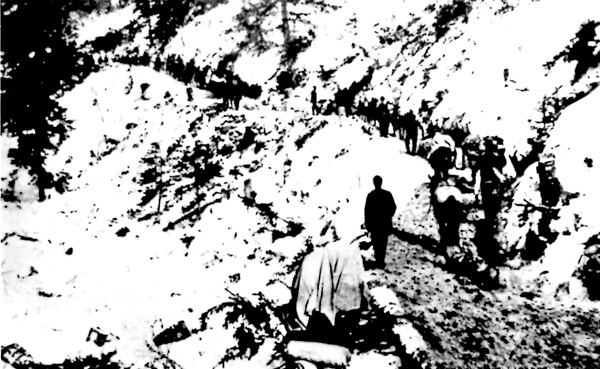
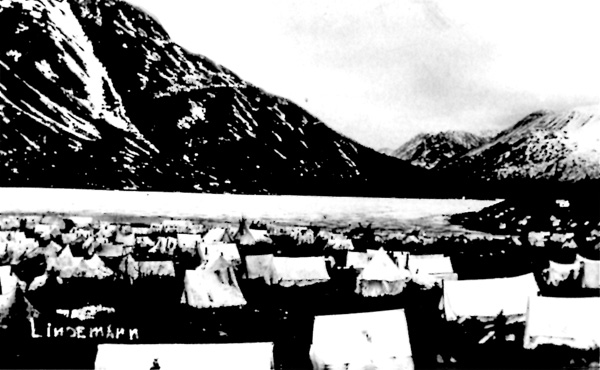
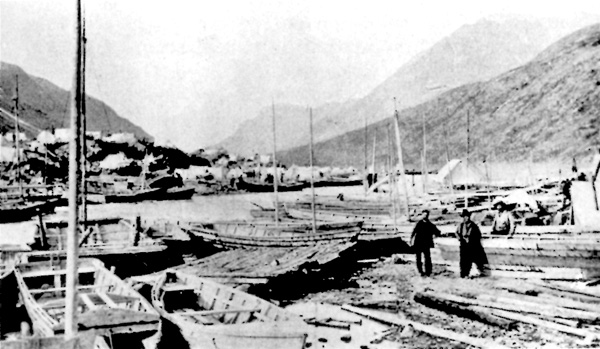
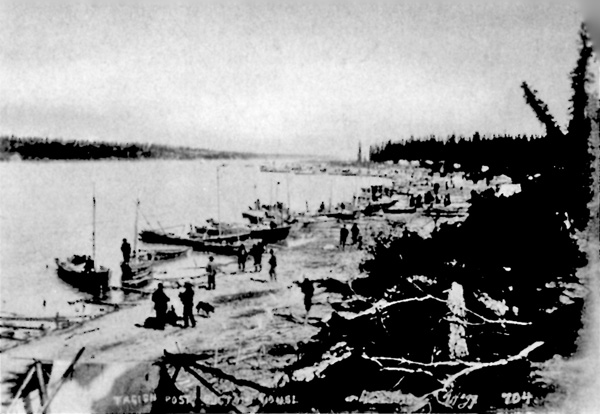
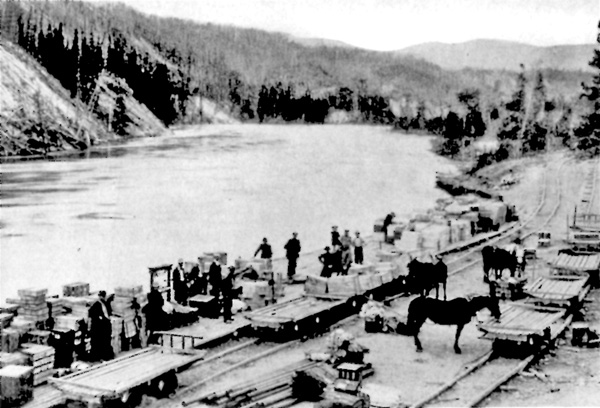
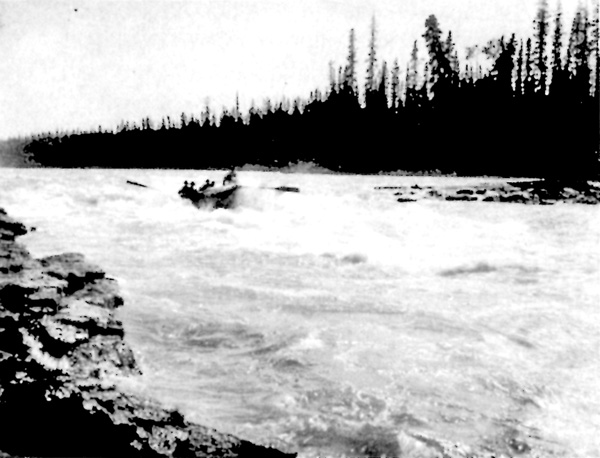
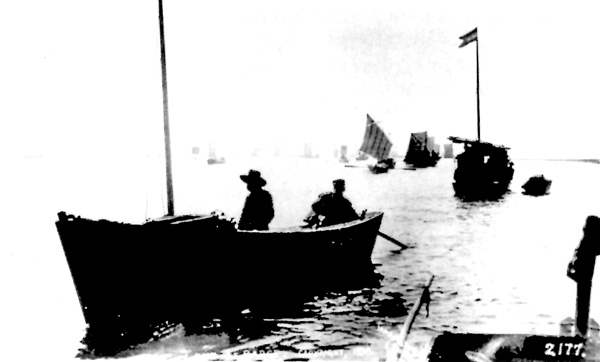
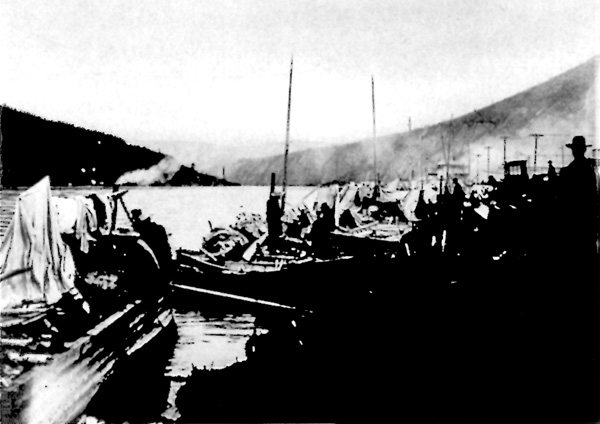
27-38 Few phenomena have been as well-documented
in photographs as the rush to the Klondike. Figures 27 to 38 show only a
few highlights. 27, A portion of the Skagway waterfront,
1898. (Public Archives of
Canada.) 28, The Chilkoot Trail
between Dyea and Canyon City. (Yukon
Archives.) 29, The Chikloot Pass
viewed from the scales. (Yukon
Archives.) 30, The last 1,000
feet to the summit of the Chilkoot Pass. (Public Archives of Canada.) 31, The wagon "road" on the White Pass Trail,
three miles from the summit. (Yukon
Archives.) 32, A portion of the
stampede settlement at Lindeman Lake. (Yukon Archives.) 33, Bennett, 1898. (Yukon Archives.) 34, North-West Mounted Police post at Tagish Lake
where every boat and its occupants were registered. (Yukon Archives.) 35, The tramline between Miles Canyon and
Whitehorse Rapids. (Public Archives of
Canada.) 36, Shooting the
Whitehorse Rapids. (Public Archives of
Canada.) 37, The Klondike armada
on Lake Laberge. (Yukon
Archives.) 38, Stampeders
arriving at Dawson. (Public Archives
of Canada.)
|
The Klondike discovery occasioned a great mass movement to Dawson,
the metropolis of the gold fields. In Dawson the population expanded so
rapidly that the supply organizations were unable to keep pace with
increasing demand. As winter descended upon the Klondike in 1897, the
prospect of starvation loomed ominously. As a result, the government
passed a regulation in January 1898 that no one was to be permitted to
enter Canadian territory without having the means of survival on his
person, or more specifically, as it turned out, on his
back.38
Just how effective this regulation was in terms of forcing the
typical stampeder to pack the legendary ton of supplies over the trail
is open to question. While much has been written about the unreliability
of many of the handbooks that purported to provide the stampeder with
information about his trip, almost all were unanimous in recommending
that the tenderfoot take enough supplies to get him over the trail and
established in the gold fields. Because the regulation requiring the
year's supply of provisions was proclaimed in January 1898 when most of
the stampeders were already on the trail, it seems doubtful that it had
much effect. There is, for example, no record of any bona fide stampeder
being turned back at the summit because he lacked the requisite
supplies. In fact, it appears that the North-West Mounted Police
regarded the regulations as a means of denying entry to "undesirables."
The fact remains, however, that packing was one of the most severe
trials that the stampeder had to suffer in his quest for the
Klondike.
Those who were fortunate enough to have money met the regulation
without difficulty. They hired Indian packers, contracted the task out
to one of the packing outfits that did business along the trail, or
procured pack animals. For those who had mortgaged themselves to the
limit in order to make the trip, however, and they constituted the
majority, the import of the regulation was quite simple — they
would have to transport their supplies on their backs. Few of them knew
at the outset how to maximize space and distribute weight in manageable
allotments. It was only through trial and error and after a great deal
of hardship that the stampeders learned to pack and move their outfits
in stout canvas bags 50 inches long. Arranging the pack so the centre of
gravity rested on the shoulders, with a strap around the forehead to
give extra support, the typical stampeder transported 50 to 60 pounds at
a time. The outfit was moved in relays of about five miles and
cached, the process being repeated until the entire outfit had moved
from the coast to the lakes. The relay system had the effect of
concentrating all the traffic on one part of trail, a fact that resulted
in numerous blockages, loss of time and general deterioration of the
trail. In all, about 30 trips were needed to freight an outfit from one
cache to another and 90 days to move it over the trail from the coast to
the head of navigation at Bennett Lake. It has been estimated that by
the time a stampeder had completed this task he would have walked at
least twenty-five hundred miles.39
The route leading over the White Pass, while less popular than its
rival, the Chilkoot, attracted some five thousand of those who stampeded
to the Klondike in 1897-98. This pass, named by William Ogilvie in
1887 after Sir Thomas White, then minister of the Interior, had been
known for ten years before the gold rush.40 Captain William
Moore, a former steamboat captain, is generally credited with its
discovery. Between 1887 and 1897, Moore and the White Pass, which he
virtually came to regard as his personal possession, waged competition
with their rivals John J. Healy and the Chilkoot Pass in an attempt to
siphon off the traffic going into the interior. Despite Moore's
endeavours, however, the White Pass remained unused until the gold rush
when it was suddenly thrust into prominence.
The White Pass route had two great advantages over the Chilkoot
route: Skagway, at the foot of the White Pass, had a harbour whereas
Dyea did not, and the trail through the White Pass was low enough to use
pack animals over the summit. As a result, pack animals were shipped by
the hundreds to Skagway. Of all the animals that were employed as beasts
of burden, horses and mules proved to be the most adaptable to northern
conditions. Burros were too small and oxen were too slow to traverse the
boggy ground so characteristic of the White Pass route. At first some
attempt was made to make the trail passable for the pack animals and
some stretches of corduroy were laid, but, as one observer pointed out,
"the moment a horse could by any means be got over the trail, all
further improvement ceased and was never again
resumed."41
The great demand for horses on the White Pass Trail during
1897-98 was reflected in the $300-price which horses commanded in
Skagway. A few enterprising men recognized that here was a mine
potentially richer than the gold fields themselves and horses that had
been slated for the glue factory only days before found themselves
relegated to the hell of the Skagway trail. As Robert Kirk noted, even
excellently conditioned horses fell victim to the ignorance of their new
masters, the weather, the bad trail, the poor food and the lack of rest
that awaited them in Skagway.42
By late 1897 the White Pass route on the coastal side of the summit
had become so littered with the carcasses of horses that the stampeders
were referring to it as the Dead Horse Trail. In their insane urge to
reach Dawson as quickly as possible, the stampeders had made no
improvements. The boggy trail had deteriorated under the constant
pounding of feet to the point where it became impassable. As a result,
the trail was temporarily closed and a wagon road was built by George
Brackett to White Pass City, ten miles up the trail from Skagway.
Brackett charged a toll of $20 a ton for the use of his road, but,
unlike the toll that was charged for the use of the stairway of ice on
the summit of the Chilkoot, Brackett encountered one problem after
another in his attempts to collect it.43
The trails leading over the Chilkoot and White passes converged on
Bennett Lake, the former via Lindeman Lake. During the winter of
1897-98, a tent city, well in excess of ten thousand people,
mushroomed at the head of the lake as stampeders stopped to build the
motley armada that would carry them down the Yukon River system after
the spring break-up.44 Although knock down boats constituted
a standard item in most Klondike outfits and many stampeders packed the
necessary construction materials over the passes, the demand for boats
so exceeded the capacity of what few shipbuilders there were that
priority was given to the construction of large freight scows. These
freight scows, built by such contractors as King's Sawmill and Shipyard.
were made of two inch planking, forty-two feet long, and twelve
feet wide, with straight sides. They were square at both ends,
but sheered up like a barge, with pointed outriggers running
about eight feet at the bow and stern, and a long heavy sweep at
the end. They were decked fore and aft for eight feet, with the
middle open, and a plank ran around the sides to walk on.
Each scow had a mast about twenty feet high, rigged with a square
sail. The mast was set about eight feet back of the bow, so that a man
could work the sweep in front of it. Sails were used only when crossing
the lakes. Usually a tent was placed over the cockpit in the middle.
After the cargo was loaded, this was where the crew lived,
cooking on a little sheet iron stove. The scows were unpainted, were
capable of carrying twenty tons, and drew from 24 to 26
inches.45
A similar problem of supply and demand beset sawmill operators who
had established themselves at Bennett to satisfy those who could not
afford the price of a ready-made boat ($300 to $500) or had failed to
include the requisite materials in their outfits.46 A
shortage of labour exacerbated the situation when few stampeders showed
any inclination to work for wages and possibly defer their arrival in
Dawson. The problem was partially alleviated when a compromise was
worked out whereby those who wanted boat lumber supplied the mill with
raw timber and took lumber that had already been cut into boards to
build their vessels.47 For most of those who streamed north,
however, cutting timber for their own use and assembling boats of their
own manufacture was the rule.
After the lumber was whipsawed, a frame was constructed, the sides
and bottom were nailed to the frame and the cracks were caulked and
pitched. Then the oars or poles were cut, a mast erected and seats
nailed down for the last leg of the race for Dawson.48 To
increase the speed of these vessels — some fragile and unseaworthy,
some barely adequate, and only a few built well enough to ensure safe
passage down the watercourse — the stampeders used blanket sails
and "current sails." The current sail was a device consisting of a piece
of canvas weighted with rocks and dropped into the water. The
undercurrent catching this submerged sail countered contrary winds and
augmented downwinds where the water was deep enough so the current sail
did not drag on the bottom.49
Having survived the perils of the trip up the coast, the adversity of
the passes and the misery of the whipsaw pits at Bennett, the stampeder
had yet two more serious obstacles to face — Miles Canyon and the
Whitehorse Rapids. The canyon, a turbulent, dangerous stretch of water
at the foot of which was a series of rapids, was to claim several lives
before the North-West Mounted Police passed a regulation that only
skilled pilots were to take boats through Miles Canyon and the
Whitehorse Rapids.50 Fines of $100 were levied against all
who violated this rule. The regulations also prohibited women and
children from accompanying the pilot through the canyon to the foot of
the rapids although this prohibition was occasionally evaded. The
pilots, who were licensed by the North-West Mounted Police, charged $20
to $25 for each boat they took down. One of the most famous of them was
Jack London, who was later to gain fame as a popular novelist. On a
good day a pilot could make ten trips, returning to the head of the
canyon from the foot of the rapids on horseback.51 One look
at this violent stretch of water, however, persuaded many a stampeder
against trusting the fate of his possessions to the skill of a pilot. As
a result, a windlass was rigged up on the east side of the river in the
spring of 1898 to haul the boats out of the water and a tramway was
built by Norman Macaulay from the head of Miles Canyon to the foot of
the Whitehorse Rapids, a distance of about five miles. The tramway
consisted of peeled logs, eight inches in diameter, over which horses
pulled wagons with cast-iron concave wheels. The freight rate on
Macaulay's tramline, which he named "The Whitehorse Rapids Tramway
Company," was three cents a pound and an additional $25 was charged
for each boat. Shortly thereafter, another tramway, this one six and
one-half miles long, was built on the west bank by a John Hepburn, but
the competition affected both operations and Hepburn sold out to
Macaulay for $60,000.52
Once through the Whitehorse Rapids, the way to Dawson was unimpeded
except for the minor obstructions at Five Fingers and Rink rapids. These
obstacles, however, were not difficult to negotiate with boats of the
size used by the stampeders. By mid-June the flotilla began to stream
into Dawson.53 The ordeal of the past few months meant
nothing. The success or failure of the stampede was now to be
determined in the Klondike gold fields.
IV
The gold rush gave birth to many elaborate transportation schemes for
facilitating the movement of men and supplies into the Yukon. This was a
natural response to the news coming out of the Klondike that gold was
there for the taking. A myth was in the process of being created —
that nuggets of gold covered the Klondike landscape in such profusion
that they only awaited some lucky soul to gather them up. Nor was this
myth challenged by those who had struck it rich in 1896-97 and who
now found themselves deluged by gold seekers eager for information about
the Yukon, "You might just as well believe what you hear," the former
confided, "because you just can't tell lies about Klondike. It's all
true."54 In the popular imagination, therefore, it was
neither the finding nor the mining of the gold that caused people to
hesitate about leaving for the Klondike; the obstacle to be overcome
was that of getting to the gold fields themselves.
It is hardly surprising that two of these transportation schemes
which promised to convey the prospective stampeder to the Yukon without
the exertion required by more conventional forms of transportation were
based on inventions that had captured the popular imagination of the
time: the bicycle55 and the balloon. In Kalamazoo, Michigan,
a man by the name of Frank Corey built an airship to carry him to the
Klondike when news of the phenomenal discovery broke in the American
press. Corey's plan was to take two men on the inaugural flight so each
of them could stake claims and thereafter to run fortnightly flights to
the Yukon. His scheme reached its climax when requests for tickets
started to pour in, but, despite the enthusiasm it had generated,
neither the plan nor the airship ever left the ground. In Seattle,
Washington, meanwhile, the Jacobs Transportation Company invested
$150,000 in another balloon scheme, this one conceived by a Don Carlos
Stevens. It was Stevens's plan to operate regular flights from Tesklo
Bay near Juneau to Dawson and so enthusiastic did he become about the
whole thing that he let it be known that when he got to Tesklo Bay he
would hang out a sign — "All Aboard for Klondike" — "and
when I've got my passengers I'll cut the rope and away we'll go." In
this instance, Tesklo Bay's proximity to Dawson, in comparison to that
of Kalamazoo's, was of little consequence. The promoters, it turned
out, had more hot air than the balloon.56
Other transportation schemes that were talked about but never made it
off the drawing boards were legion. The Pullman Palace Car Company
completed a prototype for an electric sleigh which the Great Northern
Mining and Transportation Company intended to use on the Klondike
creeks. Complete with steam heat, electric lights and elegant interior
appointments, the prototype was designed to travel at the then
breath-taking speed of 60 miles an hour. The degree of disappointment
felt by Yukon plutocrats and would-be plutocrats must have been great
when news was received that the scheme had failed, but unfortunately
their disappointment was never recorded. Another solution to the
northern transportation problem was conceived by the Klondike Combined
Sledge and Boat Company, which designed a steel sledge and barge which
it intended to market in the summer of 1898. This contraption had sails
and oars, air chambers for buoyancy and, as an added inducement,
burglar-proof compartments for gold. Like its predecessor, this scheme
suffered an unheralded end and one can only speculate whether its
failure was the result of impracticality or the end of the gold
rush.57
The experience of a stampeder setting out from Edmonton would tend to
suggest the former. He also built a "sleigh-boat," the overland motive
power for which was to be supplied by a horse until a river was reached,
at which point the device would be capsized to make a boat. The one
problem never resolved by the inventor, however, proved to be the
contraption's failing. "When the snow and ice were on the ground," an
eyewitness remarked incredulously, "the rivers were also frozen."
Edmonton was privy to another scheme which did make some sense. This
device was a steam sleigh which had a cogwheel for traction.
Nevertheless, the progress it made failed to create a favourable
impression — only 18 inches. The steam sleigh only bored itself
deeper and deeper into the ground as a result of the action of the
cogwheel. Other ideas which attracted attention during the gold rush
included carts mounted on buggy wheels and large unicycles around which
platforms had been built.58
Two other schemes to expedite the movement of supplies, particularly
food, had Scandinavian origins. The first was made by a captain of the
Royal Norwegian Army, Nils Muller, who suggested to Clifford Sifton that
a series of stations be built between the coast and Dawson, and manned
by a corps of Norwegian skiers. Muller wrote that
A skiloper with a full load of provisions is able to cover 15
miles per day — with one or two days provisions about 30 or
35. But with a sufficient number for relieving at each station the
distance between Dawson City and Dyea may easily be covered in 8
days — counting 20 working hours per day.59
How this mode of human transport was to adequately supply the
needs of some thirty thousand people was never answered and for its part
the Department of the Interior showed no interest in finding out. In the
meantime, the Alaska missionary, Sheldon Jackson, had persuaded the
United States government to relieve the food crisis by driving a large
herd of reindeer overland from the coast, the reindeer to supply not
only transportation, but ultimately the fare of hungry Dawsonites. Like
its predecessors, this scheme failed when most of the reindeer died of
starvation before reaching their destination.60
Of the many transportation schemes that were stillborn during the
gold rush, none was more interesting nor perhaps more deserving of
attention than the proposal for a monorail. The brain child of a David
Jones from San Francisco, the monorail appeared to be an effective
answer to the northern transportation problem. Its originator claimed
that "it can be carried above the snow and the line can always be
available for service, it can be run over steep grades either by
friction rollers or cog and back gearing and could be built
rapidly."61 Unlike so many others who were out for some fast
money, James did not want to sell his plan; rather he sought employment
in the civil service to develop his scheme. However, the Canadian
government gave short shrift to his proposal and both his idea and his
desire for employment were refused.62
All of these transportation schemes had one thing in common: all
failed to find application for one reason or another. Many of them were
products of the hysteria that was typical of the gold-rush period,
poorly thought out, and perhaps in no way dissimilar to the contraptions
which amateur inventors try to pass off as perpetual motion machines,
but others, if not successful, were forerunners of things to come. In
the invention of the steam sleigh propelled by a cogwheel, for example,
we can see a precursor to the snowmobile, a device well-suited to the
needs of northern transportation. For the immediate future as men
conceived it in 1898, however, the solution to the northern
transportation problem was not to be found in snowmobiles. For that,
men would turn to the 19th-century panacea for all transportation
problems — the railroad.
V
The Klondike gold rush caused a stampede of railroad incorporations
which in its own peculiar fashion was as great as its human counterpart
over the passes. In 1897, 32 railroad companies applied for federal
charters to build lines into the Yukon. In the same year the Province of
British Columbia incorporated 10, while between 1897 and 1899 another 12
filed articles of incorporation in the United States.63 In
1897 the Canadian government commissioned a series of surveys to
determine the most feasible route for a railway and in 1898 it sponsored
its own scheme to build a line between the head of navigation on the
Stikine River and Teslin Lake.64
The one railroad scheme that finally materialized was not wholly
inspired by the gold rush. In 1895 a group of English capitalists who
had formed the British Columbia Development Association sent one of
their number, Charles Herbert Wilkinson, to Canada's westernmost
province to investigate investment prospects. From Ernest Billinghurst,
the brother of another member of the syndicate, Wilkinson learned of
Captain William Moore. Moore, discoverer of the White Pass and its
foremost promoter, had previously sought money from Billinghurst to
develop a route over this pass. Consequently Billinghurst introduced
Moore to Wilkinson. Wilkinson showed enough interest in Moore's scheme
to send Billinghurst to Skagway. Billinghurst reported favourably and in
1896 a decision was made by the syndicate to proceed with a
transportation project of an undetermined nature. A small sum of money
was placed at Moore's disposal and in 1896 Moore used this money to cut
a rough trail a few miles out of Skagway.65 This initial
development work was followed by the incorporation of two Canadian
companies in May and June of 1897, the British Columbia-Yukon Railway
Company and the British Yukon Mining, Trading and Transportation
Company, to build a railroad from the summit of White Pass to the
trading post of Selkirk on the Yukon River.66 The absence of
enabling legislation providing for railroads in Alaska prevented the
syndicate from obtaining a right of way between Skagway and the
summit.67
The incorporation of these two companies predated the beginnings of
the Klondike stampede by some three weeks. Thus the decision to build a
railroad into the Yukon, if not actually proceed with its construction,
was not a result of the gold rush. In fact, considering the short
duration of most gold rushes, the Yukon's remoteness and the cost of
building a railroad over such difficult terrain as the Alaska Panhandle,
the gold rush was not of itself an altogether attractive proposition for
investing in a transportation system as permanent as a railroad. This is
not to suggest, however, that the promoters were unaware of the Bonanza
Creek discovery nor that the discovery had no effect in their application for
the railroad charters. As Tappan Adney has pointed out, the Klondike
discovery was "common property outside six months before" the
Portland and Excelsior caused the "acute attack of
insanity" that precipitated the stampede.68 What should be
noted is that other factors not directly related to the gold rush played
an important role in the syndicate's decision to build the railway.
Information culled from official and unofficial sources suggested that
gold was not the only resource which could be profitably exploited.
Reports concerning grazing land, timber and other metals indicated that
the Yukon had a potentially rich and diversified economic base, a
crucial consideration in light of past gold rushes and the exhaustible
and nonrenewable nature of gold mining.69
When news of the Klondike discovery broke in the English press in
August of 1897, the British Columbia Development Association found
itself in an excellent position to exploit the transportation potential
of the ensuing stampede. The syndicate, however, had fallen on bad times
and a lien was taken on it by the English financial house of Close
Brothers. When the syndicate failed in March 1898, Close Brothers
appropriated its assets, including the two railroad charters that had
been secured the previous spring.70
On 29 March 1898 Close Brothers obtained a West Virginia charter to
build a railroad between Skagway and the summit of White Pass. With the
passage of a bill "Extending the Homestead Laws and Providing for Right
of Way for Railroads in the District of Alaska" by the United States
Congress on 14 May 1898, and the subsequent approval by the secretary of
the Interior of the company's application for a right of way from
Skagway to the summit, the last legislative obstacles to a
Skagway-Selkirk railroad were overcome.71
In the meantime, a representative of Close Brothers, Sir Thomas
Tancred, had travelled to Skagway to determine the feasibility of
building the railroad. With two United States representatives of the
firm, Samuel H. Graves and E.C. Hawkins, in tow, Tancred arrived in
Skagway in April.72
Once in Skagway, Graves and Hawkins made a preliminary survey of
possible routes leading over the White Pass. After a cursory examination
of the area, they met with Tancred in the bar of the St. James Hotel in
Skagway. There they discussed the feasibility of building the railroad
and debated what recommendations Tancred should relay to the investors
on his return to England. On the basis of their survey, Graves and
Hawkins were agreed that the rail line could not be built. At this point
the discussion was on the verge of breaking up and with it the railroad
scheme when something occurred that was to be of major consequence for
the railroad scheme, the subsequent course of transportation history in
the Yukon and indeed the history of the Yukon Territory itself. Michael
J. Heney, an independent railroad contractor, had overheard their
conversation. Heney, who had been lured to the north by the vision of
building a railroad into the Yukon, had conducted an extensive survey of
the area leading out of Skagway and was convinced that a railroad could
be built. The only thing he lacked was capital. With the conviction of a
man obsessed and the persuasiveness of one who knew that his dream hung
in the balance, Heney set out to convince Tancred, Graves and Hawkins
that he was right. His determination and his experience won the Close
Brothers' representatives over. On 27 May 1898, men and supplies were
landed at Skagway. The following day construction
commenced.73
The construction phase was beset by many problems. Skagway was over a
thousand miles from Vancouver, Victoria or Seattle, the nearest supply
bases, and the only connecting transportation service was by water. The
capacity of the coastal steamer fleet that served Skagway and other
points on the Panhandle, moreover, was taxed to the limit by the
stampeders. With the end of the gold rush a momentary respite ensued,
only to disappear with the outbreak of hostilities in Cuba and war with
Spain. The war brought the United States government into direct
competition with the railroad for transportation services on the coast
and the American government forced its advantage by pressing
practically every available vessel on the Pacific coast into government
service. In Alaska the terrain over which the roadbed was to be laid
was devoid of material adequate for ballast and as a result, ballast had
to be hauled from the bed of the Skagway River at one end and from
Fraser at the other. These difficulties were exacerbated by an
insufficient labour supply. "It was obviously out of the question to
engage men in the ordinary way and convey them in hundreds at our cost
to Skagway, the first president of the railroad later recalled, "because
while the gold fever was at its height, the moment they set foot ashore
in Skagway would be our last glimpse of them."74
Nevertheless, the harsh reality of the gold rush partially offset this
problem. There were literally hundreds of vagrants in Skagway awaiting
the arrival of friends, money or both before hitting the trail for the
gold fields. Here was a ready-made labour market if, albeit, an
unskilled one. But these vagrants were also a "captive market" and the
merchants of Skagway who dominated the town council realized that once
the railroad began operating, their captive market would disappear. As
a result, the town council made it known that it expected the railroad
to pay for the privilege of operating out of Skagway and if this failed,
the council threatened to seek an injunction preventing the railroad
from laying track on that section of the roadbed that ran through
town.
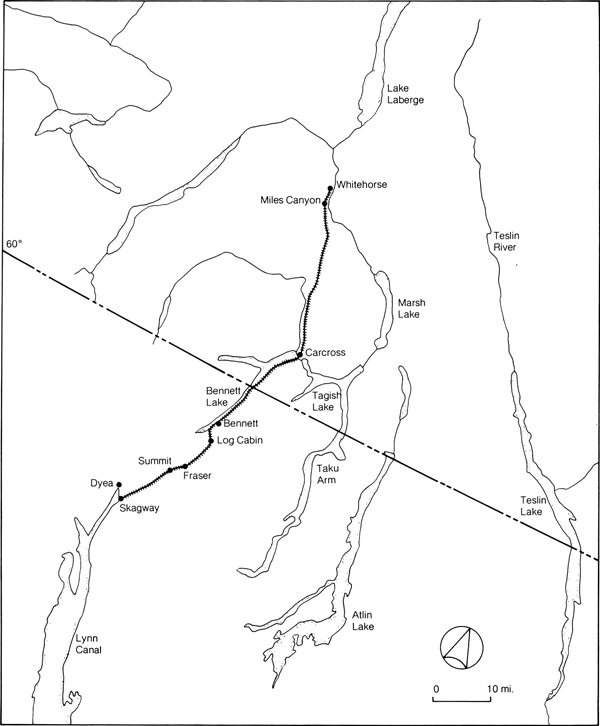
39 White Pass and Yukon Route railway.
(Map by S. Epps.) (click on image for a PDF version)
|
When the controversy was at its height and while the town council was
engaged in a volatile meeting, the railroad crews worked through the
night. By morning the track was laid. Presented with a fait
accompli, the town council capitulated.75 Despite this
small success, however, the company's labour problems were not fully
overcome. Turnover continued at a rapid rate as men, heretofore forced
to remain in Skagway for a variety of reasons, found these reasons
obviated with the arrival of their friends or money. No longer
restrained, they would drop their tools and leave for the
Klondike.76
Like so many other transportation projects of the period, the White
Pass and Yukon Route77 railway was built with the intention
of returning an immediate profit to its investors. But while other
transportation companies, cognizant of the boom and bust nature of the
gold-rush phenomenon, operated on the "high-grading" principle with
planned obsolescence in mind, the railroad was designed as a permanent
fixture in the Yukon transportation system. It would be built, Samuel
Graves noted,
in the belief that the line that would pay best was
a well located one, with the lowest possible gradients and a very
solid roadbed over which heavy engines could haul heavy loads up the
hill in summertime, and which would admit of modern appliances for snow
fighting in the winter.78
The intentions of those on the site, however, could and often did
exceed the expectations of observers in Skagway and indeed the
expectations of some of the investors themselves. In Skagway local wags
referred to the project derisively as the "Jackass and Yukon Railway,"
while in England some of the less enthusiastic shareholders tried to
jettison the scheme with arguments in favour of a
tramline.79 But the contractors and the Close Brothers
representatives in the field persisted and as the weeks slipped by the
line finally began to take shape.
By 21 July four miles of track had been completed.80 This
brought the roadbed to the foot of the pass where the most difficult
section in terms of construction would begin. Here the White Pass rose
to an altitude of 2,885 feet in 14 miles. In order to reduce the
gradient, 21 miles of track were required. The problems involved in
finding a satisfactory roadbed for the additional 7 miles of track were
complicated by Brackett's wagon road. The right of way that Brackett had
reserved for his road was the most direct and feasible line to the
summit and while the roadbed for the railway could cross this line, it
could not run parallel to it. Finally, after several attempts to skirt
Brackett's road, which were made even more costly by the need to remove
debris that constantly fell on the wagon road as the railroad crews
carved out the roadbed, the White Pass and Yukon Route bought Brackett
out.81 As the railroad slowly inched its way up the pass to
Heney Station during August of 1898, word of the gold strike at Atlin,
British Columbia, reached the construction camps. Its impact was immediate
as an estimated 65 per cent of the work force abandoned their jobs
and stampeded to Atlin. It was not until October that the company was
able to replenish the crew to their pre-Atlin levels and by that time
two valuable summer months of construction time had
elapsed.82
With the onslaught of Alaskan winter, construction entered a new
stage. Winter work required an almost superhuman effort. "The strong
winds and severe cold made the men torpid, and benumbed not merely their
bodies but their minds," Graves wrote, "so that after an hour's work, it
was necessary to relieve them by fresh men."83 At mile 15 the
crews reached the most difficult stretch on the line. Here a
perpendicular wall of granite rose nearly two thousand feet from the
canyon floor. Polished by the action of long-extinct glaciers and worn
sooth by the winds that ripped through the pass, this stretch presented
a problem of the severest order. Working on platforms supported by
crowbars drilled into the granite below and suspended by ropes secured
from above, the labourers blasted and hacked the face of the rock until
a tenuous horizontal ribbon had been cut for the roadbed. A mile further
on, a tunnel 250 feet long was bored through the mountain. At mile 19,
the Dead Horse Gulch Viaduct, a switchback 215 feet above a
rock-strewn stream was built. Finally on 18 February 1899 the summit
was reached. Two days later freight and passenger trains were placed in
service.84
Once over the summit, construction proceeded apace to the head of
Bennett Lake. To facilitate supply, Heney organized a teamster operation
which doubled as a passenger- and freight-carrying service between the
summit and the lake. When the railroad reached Bennett on 6 July 1899,
the horses and wagons were withdrawn and made ready for use over the
frozen surface of the lake that winter.85
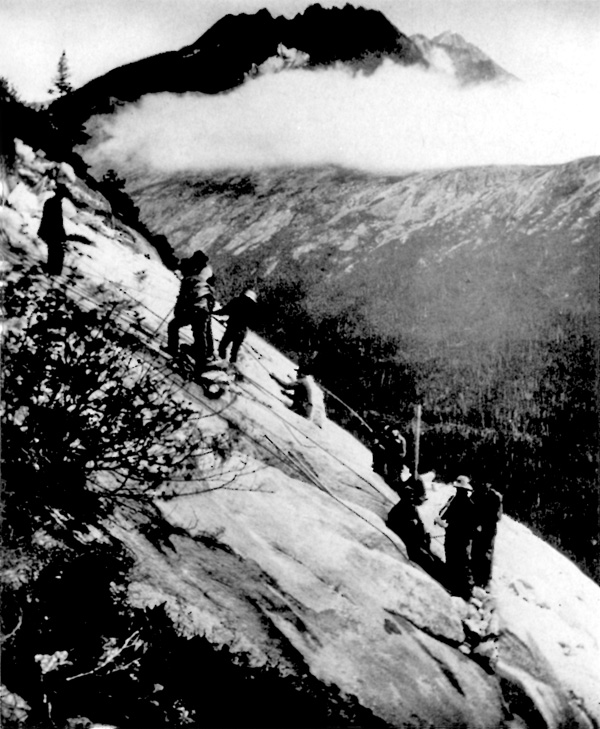
40 Cutting the grade for the White Pass and Yukon Route railway on
Tunnel Mountain.
(Yukon Archives.)
|
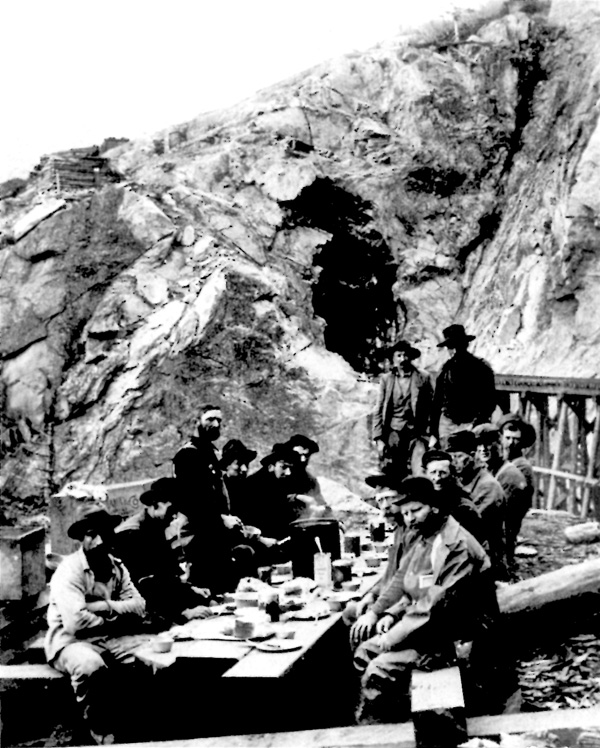
41 A crew pauses for a noon meal at the entrance to the tunnel.
(Yukon Archives.)
|
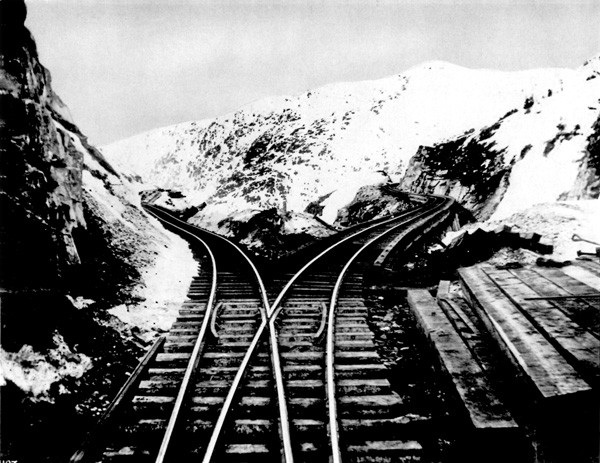
42 The switchback at mile 19.
(Yukon Archives.)
|
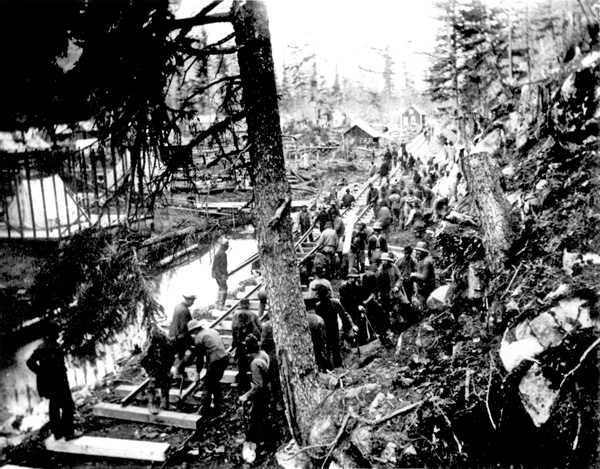
43 A railroad crew clears the grade and lays track. Occasionally
the rails dipped and swayed with the configuration of the ground.
(Yukon Archives.)
|
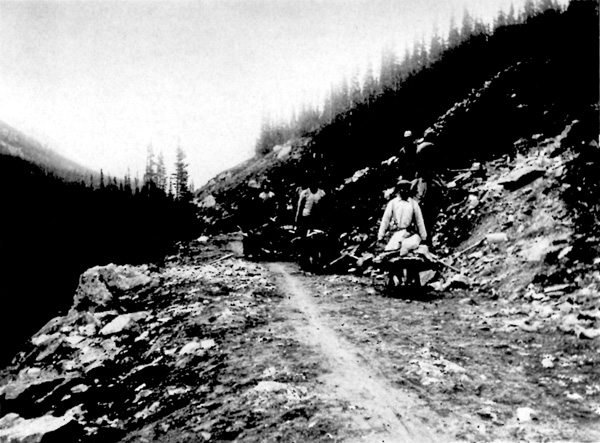
44 Wheelbarrow crews remove rock near the summit of White
Pass.
(Yukon Archives.)
|
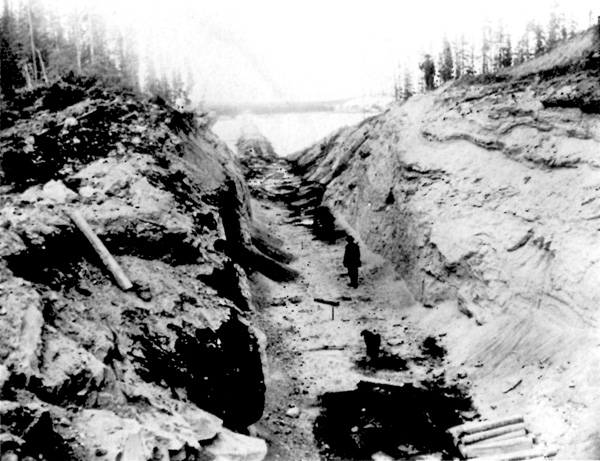
45 A cut through glacial frost and what appears to be a
causeway in the distance.
(Yukon Archives.)
|
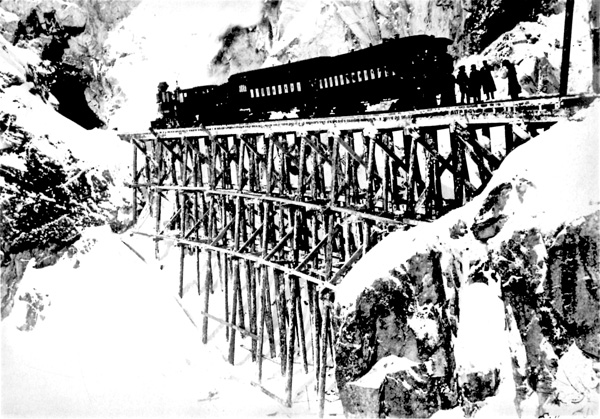
46 The first passenger train to the summit of White Pass.
(Yukon Archives.)
|
From Bennett the survey called for the line to skirt the eastern
shore of the lake to Caribou Crossing (now Carcross). Because heavy rock
blasting was required on this section, the company transferred most of
its operations to the Caribou Crossing-Whitehorse section with the
exception of the rock crews which were left to cut out the road beside
the lake. The decision to complete the first and last sections of the
railway before tackling the middle made it necessary to move rails,
engines, rolling stock and other material over the middle section to
Caribou Crossing. For this purpose the lake was used as a connecting
link and a power barge was built. As with Heney's horse-drawn wagons
that had operated between the summit and Bennett, the barge was also
used to move people and supplies going on to Dawson.86 When
the lake froze over that fall, the White Pass and Yukon Route organized
the "Red Line Transportation Company." This cartage service moved "a
large number of passengers and hundreds of tons of freight, including
material, engines and boilers etc., for a number of steamers built at
the head of Lake Bennett that spring." On 8 June 1900 the Caribou
Crossing-Whitehorse section was finished. In the meantime the company
had bought out Macaulay's tramlines at Miles Canyon and Whitehorse in
order to secure a right of way. With the completion of the line between
Caribou Crossing and Whitehorse, a through transportation service was
inaugurated between Skagway and Whitehorse, utilising the power barge on
Bennett Lake. Finally, on 29 July 1900 the Bennett-Caribou Crossing
section was completed. The following day through trains between Skagway
and Whitehorse began operating.87
When completed, the White Pass and Yukon Route railroad was 110.7
miles long. Of this, 20.4 miles of track were in Alaska, 32.2 miles in
British Columbia and 58.1 miles in the Yukon Territory. The railway was
of the narrow-gauge (three feet) type, 45-pound rails having been used.
From Skagway to the summit of White Pass, the most difficult stretch in
terms of construction and maintenance, the line ascended 2,885 feet. The
maximum gradient on this section was 3.9 per cent, the average being
2.6 per cent. The highest elevation was not at the summit of the pass,
however, but at Log Cabin, British Columbia, mile 33, where the railroad
reached an altitude of 2,916 feet. The average track curvature on the
Alaskan side ranged from 16 to 20 degrees. The total construction cost
was approximately ten million dollars and an additional 2.5 million
dollars were spent on rolling stock and equipment.88
All told, some thirty-five hundred men were employed at one time or
another while the railroad was being built. Of this number, 35 died from
all causes including illness as well as accident.89 Writing a
few years after the railroad had been in operation, Graves noted that
probably "no other railway in the world was built by such highly
educated men as worked on our First Section." This phenomenon, a
demographic product of the Klondike stampede, was only one of the
remarkable factors associated with the building of the railroad. Another
was the "White Pass spirit" that prevailed during the construction
phase.90 Except for a short strike in March 1899, which was
precipitated by the company's decision to reduce wages and extend the
working day, no other serious labour-management problems were
encountered.91
As the first train ever to ride on the new rails confidently made its
way from Whitehorse to Skagway, pulling the empty cars which had
accumulated in Whitehorse since June of 1900, an Irish crewman remarked,
"Be Jakers — the first thrain into this country was a thrain OUT."92
Whether he realized it at the time or not, this Irishman perceived
both the challenge and the continuing dilemmas that were to confront
the transportation system of the Yukon, and indeed the Yukon itself, for
the next half century.
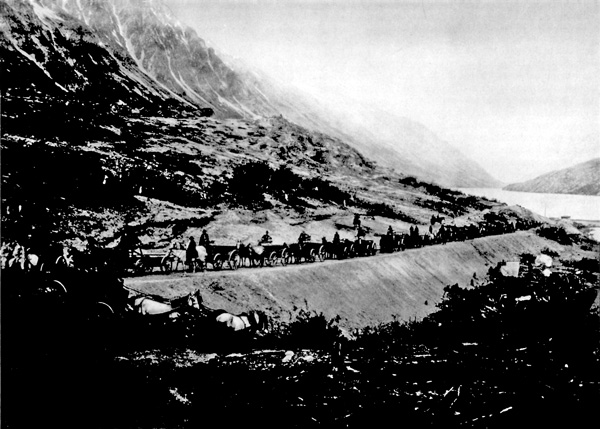
47 The Red Line Transportation Company's last run into
Bennett from the summit, 6 July 1899.
(Yukon Archives.)
|
VI
The pressure of the gold rush on the river transportation system had
an immediate impact that was reflected in the tremendous expansion of
navigation facilities. By August of 1898, 30 additional transportation
companies had joined the original firms, the Alaska Commercial Company
and the North American Transportation and Trading Company, in the
competition for traffic on the Yukon River. Taken together, these
companies operated some 60 sternwheelers, 20 barges and 8
tugboats.93 Despite the unprecedented pressure on the
navigation system, however, the gold rush did not result in the
introduction of any new forms of water transportation. The sternwheeler
retained its role as the basic form of river communication during the
period. While the gold rush was not accompanied by any qualitative
changes in sternwheeler technology, it was marked, nonetheless, by a
significant modification in water routes to the Yukon interior. Before
1898 the sternwheeler had worked the lower Yukon exclusively.
Sternwheeler traffic originating at Saint Michael had never been extended
above Robert Campbell's old fur-trading post at Fort Selkirk. It was
for this reason that Fort Selkirk had been designated the original
terminus of the White Pass and Yukon Route railway.94
The gold-rush popularity of the upper river system was to have a
significant effect on the transport function of the upper and lower
routes. While thousands of people busied themselves in the spring of
1898 building the wind- and pole-propelled vessels that would convey
them from Bennett Lake to Dawson when the ice broke up, a few began the
historic experiment of assembling the steam-powered craft they had
sledded over the passes the previous winter. Though there is some
dispute as to which sternwheeler was the first to successfully navigate
the upper river between Bennett and Dawson that spring,95
that controversy is less important than the success of the experiment
itself. An historic breakthrough had been accomplished — steam had
been introduced on the upper route. The effect of this achievement
was to be of profound consequence for the future of the Yukon
transportation system.
Having demonstrated that the sternwheeler could be successfully used
on the upper river route, a number of sternwheelers were built at
Bennett Lake. Because of the obstacles to through navigation posed by
Miles Canyon and the Whitehorse Rapids, the fleet was separated into two
divisions — one serving the Bennett-Miles Canyon section, and the
other the Whitehorse-Dawson run.96 In 1898 the Bennett Lake
and Klondike Navigation Company operated the Flora and
Nora below Whitehorse to connect with the Dra which plied
between Bennett and Miles Canyon. These vessels were approximately 75
feet long. The trip between Bennett and Dawson took four and one-half
days. Sleeping accommodation consisted of wooden bunks ranged in tiers
of three and the passengers supplied their own bedding. The cost for the
through trip was $75. Meals were an additional dollar each. In the
meantime, the Canadian Development Company had placed the Willie
Irving, the Goddard and the Anglian between Whitehorse
and Dawson. In the summer of 1898 steam service was expanded to include
Lindeman Lake with the operation of a steam ferry to connect with
Bennett.97 The upper route proved to be so successful that it
was able to challenge the historic pattern of river transportation
dominated by the lower river via Saint Michael. As a result, various
sternwheelers like the Victoria were withdrawn from the lower run
and transferred to the upper Yukon.98
With the introduction of sternwheelers on the upper river, the
desirability of extending the railroad to Fort Selkirk, a need which had
previously existed, was obviated. Whitehorse, situated at the foot of
the major impasse to through navigation on the upper river, Miles
Canyon and the rapids, was selected as the terminus for the railroad.
When the railway was finally completed in July of 1900, the upper river
route, served by the railroad and a complementary fleet of
sternwheelers, was in a position to supplant the lower route as the main
life line to Dawson.
VII
Recalling his trip to the Klondike, Robert Kirk wrote that "the
present advanced state of development of the northern mines is due
largely to... dog-teams."99 While Kirk may well have
exaggerated the importance of dogs as a transportation factor in the Yukon
to the detriment of other forms of transportation, it must be admitted
that the dog and the dog team played a crucial role in northern life
during this period.
No one knows when dogs were first used to fulfill a transportation
need in the Yukon. The Indians used them to the extent that their
technologically primitive society demanded and the
Hudson's Bay Company had utilized dogs in the prosecution of the fur
trade. With the coming of the prospector in the 1880s, the use of dogs
had declined in proportion to the falling off of the trade in furs. This
occurred in part because the mines were worked during the summer months
only. Many of the miners left for the outside before the annual fall
freeze-up, while the rest passed the winter months inside their cabins.
The evolution in mining technology occasioned by the introduction of
winter digging in the early 1890s and the discovery of the rich gold
fields in the Klondike in 1896 renewed the demand for dogs and dog
teams.
Dogs were used for a variety of purposes during the Klondike period:
to haul poles, logs and lumber for sluice boxes, drift burning and
cabins; to deliver mail; to reach the small outlying settlements in the
territory; to commute from creek communities to Dawson; to freight
supplies, food and equipment; to carry gold from the mines to Dawson; to
labour in the mines themselves, and to deliver water door to door before
Dawson acquired its water system. During the summer dogs were used as
pack animals; during the winter to draw sleds.100
It has been estimated that by 1899 there were some four thousand
dogs regularly employed in the town of Dawson. While most of these dogs
were privately owned, many of the transportation companies used dogs as
well. Men often made $100 a day freighting supplies to the mines and in
the spring of 1898 a return of $150 a day was not uncommon. During the
summer months gold was brought into Dawson from the mines by dog trains
consisting of 15 to 20 dogs. Each dog in the train carried a pack which
weighed between 20 and 30 pounds. An indication of the wealth conveyed
in this manner is apparent from the fact that a train of 15 dogs, each
dog carrying a 30-pound pack, transported gold to the value of $122,400
(gold valued at $17 an ounce). For two and one-half months during the
summer, the dog trains operated 24 hours a day, six days a week. During
the winter, dog punchers worked eight hours a day, averaging 20 miles
with a load of twelve hundred pounds. Occasionally, the dog teams were
relieved from freighting supplies to the creeks and used for trips to
the coast on Lynn Canal, 500 miles away. During these trips the packers
carried private mail and light express. The charge for carrying a letter
was one dollar, and the driver often increased his revenue by taking a
miner from Dawson to the coast. The passenger generally paid some $500
for the privilege of accompanying the sled, not for riding in it, and
he was expected to assist in the making of camp and the cutting of
firewood and to furnish his own blankets and robe.101
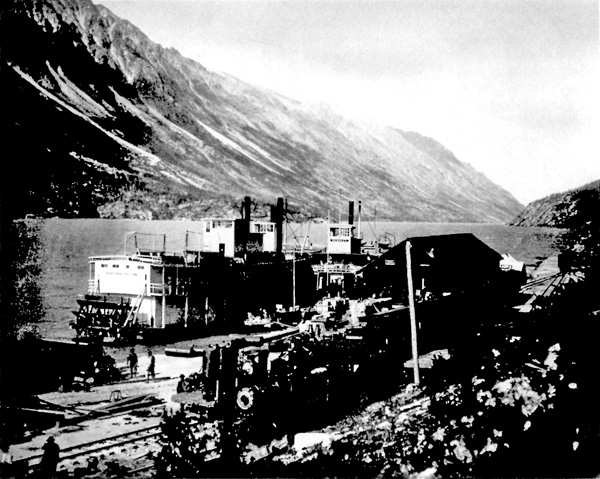
48 The Clifford Sifton, the Bailey and an
unidentified sternwheeler at Bennett. Until the railway
was completed to Whitehorse, Bennett was the head of
navigation on the upper Yukon.
(Yukon Archives.)
|
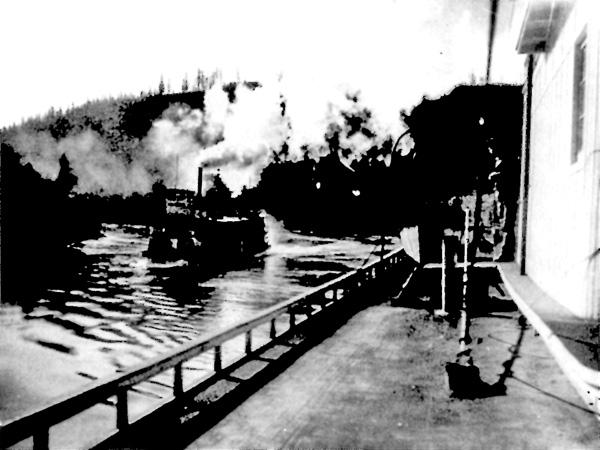
49 A steamboat race. The vessel on the right is probably the
Canadian since it and the Bailey were involved
in one of the most famous, and wisely one of the few, steamboat
races on the Yukon. According to a report in the Victoria
Daily Colonist of 29 September 1900, "the fight was a
draw. A battle royal had been fought (the Bailey rammed
its opponent twice). The Canadian, although having
somewhat the best of the struggle, was so badly damaged that
no victory was claimed."
(Yukon Archives.)
|
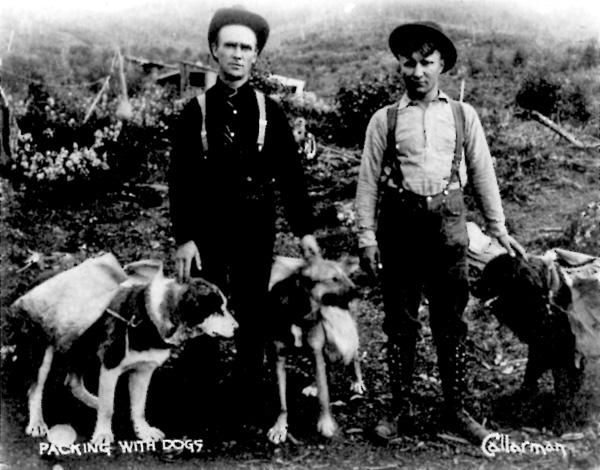
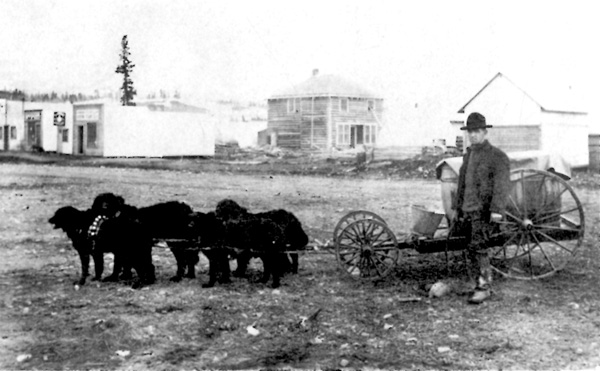
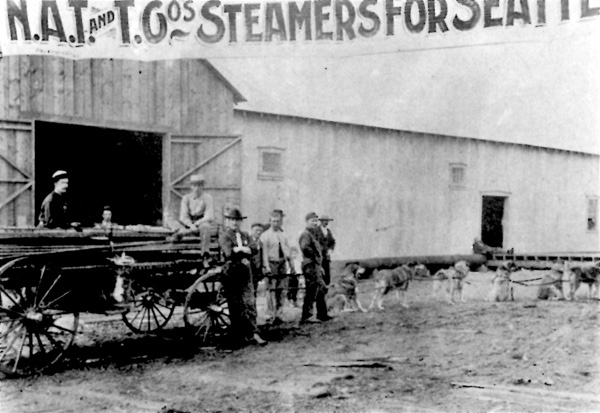

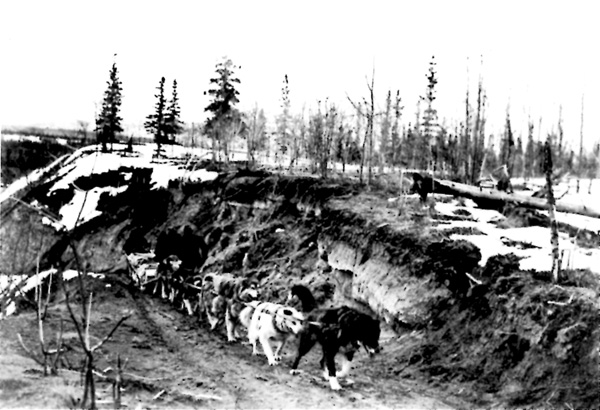


50-56 Dogs performed just about every transport function
conceivable. They packed in summer, made long-distance trips
in winter, provided Dawson and Whitehorse with primitive
"municipal waterworks," and drew loads which belied their
small size.
(Yukon Archives.)
|
Various breeds of dog were used for freighting in the Yukon. By far
the most sought-after were the native breeds; the husky, the malemute
and the "Siwash" or Indian dog. These dogs were aptly suited to the
rigours of the northern environment, being "well-boned, deep chested,
and strong in the back, fore and hind quarters," as well as having thick
outer and inner coats of hair and paws that were well-furred between the
pads and the toes. Arthur Treadwell Walden, a noted Yukon dog puncher,
preferred the husky to the malemute because it was larger and stronger,
and observed that the "Siwash" or Indian dog was generally less
preferable than either because of its supposed indolence. It is
interesting to note that Walden's ascription of greater size and strength
to the husky instead of the malemute reversed the conventional
distinction drawn by professional breeders between the two types of
dogs, thereby suggesting that Walden mistook one for the other. In
addition to their superior physical characteristics, the native dogs
showed a marked propensity for scavenging, to which the elevated food
caches that dotted the northern landscape bore mute testimony. Accounts
of their bad temper were legion as they were quick to attack one another
when confused or frightened and no gold-rush story was considered
complete with out a graphic description of a particularly vicious dog
fight.102
During the gold rush a brisk business was done importing outside
dogs for sale. In fact, contemporary photographs give every indication
that the number of outside dogs far exceeded the number of native breeds
in use at the time. Though not as valuable as the native breeds, these
dogs proved adaptable to northern conditions, nature furnishing them
with a thick coat of hair once the cold weather had set in. They had
neither the strength nor the endurance of the native dogs and their
dietary requirements were also greater, but they were particularly
well-suited to short-distance hauling. Tappan Adney, an acute
observer, noted that for this purpose the St. Bernard and the mastiff
were unsurpassed.103
On the trail, dogs were fed dried salmon, each dog being given
approximately two pounds of fish each day. Not only was dried salmon
relatively cheap, but experience showed that it was also more nourishing
than other foods, "one pound of dried King salmon being equal to five
pounds of fresh meat." The Indians did a brisk business selling fish to
the dog punchers. When fish was not available, a concoction of bacon and
rice was prepared that was frequently adulterated with cornmeal or
oatmeal, each dog being given three to four pounds. The dogs were fed
once a day and always at night. This was done because it encouraged them
"to make better time on the trail." Another reason was that the dogs
tended to become lazy and indolent after feeding "and practically unfit
for work."104
Of all the dogs in a team the most important was the leader. During
the winter of 1897-98 when dogs were selling for $200 in Dawson,
lead dogs were commanding $300 apiece. A well-trained lead dog relieved
the driver of half the work involved in driving the team. The qualities
required in a good lead dog were those of intelligence, discipline and
responsiveness. The leader was not expected to augment the pulling power
of the other dogs. It was his job to keep to the trail and to hold the
harness taut. Leaders were generally of the native breed although this
was a matter of individual preference. Jeremiah Lynch, a former United
States senator, favoured an outside dog, believing that the Scottish
collie made the best leader. The professional dog punchers generally had
two lead dogs, one to relieve the other when breaking trail.105
The two most common types of sleds used during this period were the
Yukon sled and the basket sleigh. The Yukon sled, or standard freight
sled, originated in the Cassiar district of northern British Columbia
and was brought into the Yukon during the early 1890s. Seven feet in
length, the Yukon sled was 16 inches wide on the runners and set 4
inches off the ground. It was narrow in comparison to other contemporary
styles, a characteristic which gave it more mobility. To compensate for
this width limitation, the sled box was designed to overhang the runners
by two inches on each side, thereby increasing the carrying capacity by
four inches. The frame of the sled was light but strong, consisting of
four pine slats laid lengthwise over four crosspieces of ash. The
runners were also made of ash, with a brass plate attached to the
bottom. Wooden runners were not used alone, as the ice had the effect of
cutting them to pieces, and steel runners were apparently not popular
because they had a tendency to split in low temperatures and produced
too much friction under the same conditions. There is no evidence to
suggest that the Indian custom of shoeing the sled runners with a thin
veneer of bone was ever adopted by the white dog drivers.106
This was unfortunate as the Indian type of runner proved particularly
well-suited to northern conditions.
A "gee-pole" was lashed to the side of the Yukon sled.107
Approximately six feet long and three inches thick at the butt end, the
gee-pole extended upward from the front of the sled at an angle of 45
degrees. The gee-pole facilitated steering and was used to keep the sled
upright. It was also used to break the sled loose when the runners froze
to the surface and as a braking device when going down small
hills.108
The second style of sled, the basket sleigh, originated among the
Indians of the lower river, It was larger than the Yukon sled, varying
in length from 8 to 12 feet and in width from 20 to 22
inches, and the body was 6 inches above the runners. Unlike the
Yukon sled, the carrying surface did not overhang the runners. The
basket sleigh had a light, flexible frame that was made from hickory,
oak or white birch. The sides of the sleigh consisted of narrow wooden
uprights set at two-foot intervals, a foot high in the front and two
feet high in the rear. Each side was covered with a rail and the
interstices of the frame were filled with a netting of cord or rawhide.
Instead of a gee-pole, the basket sleigh was fitted with a plough-handle
arrangement that extended from the middle of the sleigh to the
back.109
The load that could be drawn by a dog team depended on two factors:
the dogs themselves and the condition of the trail. Under optimum
conditions a team of five native dogs could pull a sled with a
thousand-pound load a distance of 15 to 25 miles in a single day.
Generally speaking, the sled was loaded in the ratio of 160 pounds to
each dog.110 In loading a sled, weight was distributed so
that the heaviest part was in the front. The load was placed on a light
canvas sheet approximately eight feet by ten feet which covered the
bottom of the sled. Once loaded, the canvas sheet was drawn up and
wrapped around the load. Two long ropes at the end of the sled were then
woven back and forth through the side ropes to secure the sled. For
extra security, these ropes were woven through V-shaped ropes at each
end. After this was done, water might be splashed over the rope joints,
to freeze them together.111
Only after the sled had been loaded were the dogs harnessed and the
traces hitched. During the gold rush the standard dog harness consisted
of a leather collar with a back band and a belly band to which the
traces were attached. In harnessing the team, a dog puncher started with
the lead dog and worked back to the sled dog. The dogs were generally
arranged in tandem fashion rather than in pairs. Once harnessed, the
dogs were hitched together, starting with the lead dog, until the dog
in front of the sled dog was reached. Then the dog in front of the sled
dog was harnessed to a whiffletree at the front of the sled. The sled
dog was hitched separately to the whiffletree with a short pair of
traces so as to enable him to jump out of the line and pull at right
angles when the sled went around a corner.112
When the sleds were loaded, the dogs were coupled closely together to
increase their pulling power. Another set of rings at the junction of
the back band and the traces was used when the sleds were empty. This
gave the dogs an additional 18 inches between them and made it easier
for the dogs to run. Three miles an hour, or the speed at which a man
could walk, was usually as fast as the dogs could go when the sled was
loaded; when the sled was empty a dog team travelled at the rate of six
miles an hour.113 To reduce friction the runners were always
iced while on long trips a sail was sometimes used to take advantage of
fair winds.114
While it was not uncommon for a thousand pounds to be loaded on a
single sled, the experienced dog punchers generally used three sleds
when hauling heavy freight. This was done in order to distribute the
weight over 21 feet, thereby allowing a greater degree of mobility and
speed. The sleds were connected by cross-chains. Hitched together, the
three worked as one as the mode of connection forced each sled to follow
in the track of the one in front. The sleds in these "sleigh trains"
were reinforced with iron braces to reduce stress. As with the single
sleds, weight was distributed so the heaviest part was in the front, the
usual distribution being six hundred pounds in the first sled, four
hundred in the second and two hundred in the third.
If the sleds tipped over, they were righted one by one. On long hills
the sleds were unhitched and hauled up separately. On steep descents the
dogs were unsnapped and the sleds allowed to go down on their own power.
To reduce the momentum of a sled on a downhill run the driver rode on
the gee-pole by leaning back on it and using his feet as a brake. This
was considered the most dangerous part of sledding. Several fatalities
occured and in one instance a driver was impaled, but riding the
gee-pole was a necessary evil. Mechanical braking systems were tried,
proved unsatisfactory, and abandoned.115
Over-sweating was a constant problem when the dogs drew heavy loads.
To offset this condition, the driver frequently stopped and unhitched
the team to enable the dogs to cool off by rolling around in the snow.
This sudden chilling had no apparent ill effects on the dogs. The most
difficult surface for the dogs to work on was ice. Their paws, warmed by
the strain of pulling, would melt the ice, allowing frost balls to form
under their nails and between the pads. These frost balls cut the paws
like broken glass. As soon as the driver saw a dog limp he would stop
the team and thaw out the pads by putting the dog's foot in his mouth,
after which he dried the foot with his shirt. Frequently an outside dog,
ignorant of the consequences, would stand still on the ice when the team
was stopped, causing his warm feet to freeze solid to the
trail.116
On long trips, especially between Dawson and Skagway, a dog puncher
had to carry sufficient provisions to last him throughout the trip.
These included fur robes, blankets, a small tent, a small sheet-iron
stove, food for the party and for the dogs, cooking utensils, snow
goggles and snow shoes. Within these limits, the weight of the outfit
was reduced to the bare minimum as comfort was sacrificed to speed. On
the trail, men wore drill parkas, fur caps which covered the ears, and
heavy wool-lined, moose-skin mittens. Several pairs of moccasins were
carried as it was necessary to keep feet dry at all times. Drill parkas
were favoured over fur ones because the latter were generally found to
be too warm. Fur parkas were worn at night and in the early morning when
the temperatures were lower.117
On the trail the drivers and the passengers drank tea exclusively as
it was considered to be more nourishing than either coffee or cocoa.
Liquor was never touched as it dulled the senses.118
Travel on the Yukon River was difficult. The water did not freeze
evenly and the surface was rough. Wind and snow exacerbated the surface
conditions. Wherever it was necessary to break trail, the driver would
precede the dogs and pack the snow with his snowshoes. The trip to the
coast took 30 days. If light freight or express were carried, two sleds
might be taken, one of which could be dropped along the way once the
driver and team had consumed enough food to permit the balance of the
supplies to be transferred from one sled to the other. During the late
fall and early spring when the ice was not frozen during the day, it was
customary to travel at night.119
It was no coincidence that both the gold rush and the golden age of
dog transport occurred at the same time. The gold rush created the need
for a winter transportation system, a need that had been practically
nonexistent before 1896, and the demand created thereby could be met by
the only available resource — dogs. As a result, dogs and dog teams
became synonymous with winter transportation between 1897 and 1900. But
the gold rush also created pressures that were to limit the supremacy of
the dog to a brief interval. Although the dog was well-suited to
northern conditions, the gold rush underlined the fact that dogs could
not satisfy northern transportation needs adequately because of their
size and pulling capacity. Once the horse was introduced, it was only a
matter of time before it would supersede the dog. By 1900-01 the
transition was pretty well complete. Nevertheless, the dog retained
certain transportation functions which extended well beyond 1900. Of
these, the most important were communication with outlying settlements
not served by roads and in Mounted Police winter
patrols.120
VIII
Although horses had been used in the Yukon prior to the gold rush, it
was not until 1900, after it had been demonstrated that the horse could
successfully survive the Yukon winter, that horses were to supplant dogs
as the principal medium of overland transportation. Before 1896 it was
generally believed that no horse could survive the northern winter on a
diet of native hay and the demand for horses had not been great enough
to warrant the expense of importing hay for the winter season. In Circle
City, where horses had been used to pack supplies to the mines, the
entire horse population had been killed each autumn in order to prevent
mass starvation. Between 1896 and 1898 when the demand for horses
increased enormously, the exorbitant price of hay, which fluctuated
between $400 and $1,200 a ton, discouraged large importations of horses
to meet the increased demand. Yet despite inflated prices and the
limited seasonal value of horses, the teamsters who operated during the
gold rush managed to realize substantial profits. Freight charges for
horse cartage were high, ranging from a flat rate of 45 cents a pound on
gold, to 25 cents a pound from Dawson to anywhere on Bonanza Creek, 35
cents a pound to Eldorado, and 50 cents a pound to Hunker Creek for
general merchandise. One observer estimated that each horse employed in
Dawson during the gold rush earned $4,500 a season for its
owner.121
In spite of the horse's physical superiority — a horse could
draw or pack at least five times the weight that a dog
could122 — the dog retained its status as the Yukon's
primary work animal until 1899. Until the question of winter survival
could be answered affirmatively, the use of horses would always be
limited. Although William Ogilvie had reported in June 1896 that horses
"have been in use here, packing to the mines in the summer and hauling
wood in the winter for several years... notwithstanding that they live
only on the coarse grasses of the country," it was not until the winter
of 1897-98, when 12 horses were brought in from Circle City and Forty
Mile and kept working on a diet of native hay and sheltered in
stove-warmed tents, that it was popularly believed that the horse could
survive the cold.123 The successful wintering of a number of
horses in 1898-99 by the North-West Mounted Police confirmed the
year-round practicality of horse transport and was followed by the
importation of large numbers of horses the following
spring.124 In the summer of 1899 the cutting and drying of
local red-topped grass assumed the proportions of a small industry in
preparation for the winter ahead and that winter over one thousand
horses were worked.125 The primacy of the dog had been
broken.
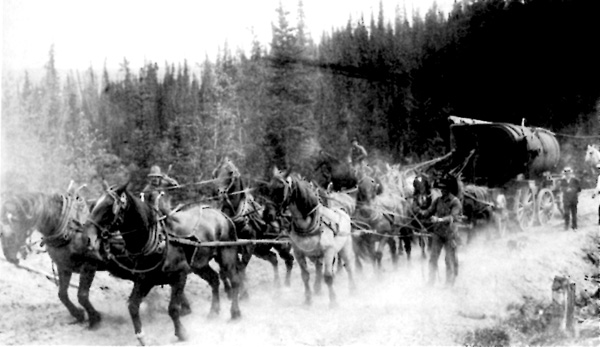
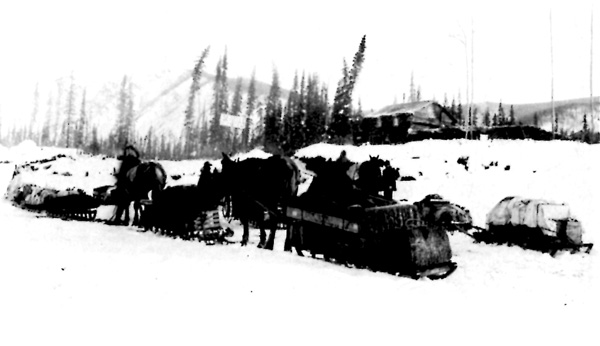
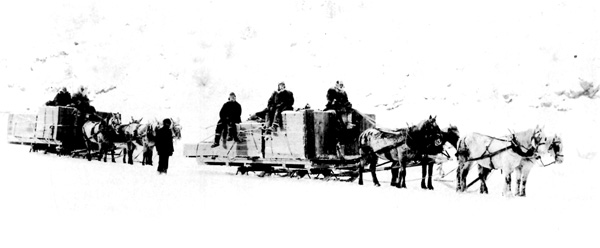
57-59 Some typical examples of turn-of-the-century teamster
operations. Figure 57 shows a team hauling a heavy boiler to
the creeks.
(Yukon Archives.)
|

60 The Klondike gold fields. (click on
image for a PDF version)
|
IX
Prior to the gold rush, no internal transportation system of any
consequence existed in the Yukon. To be sure, the basic outlines of a
domestic transport system based on water had been established as early
as the 1870s by such men as McQuesten, Harper and Mayo, but the
overriding consideration of the pre-gold-rush era had been to develop an
efficient system of communication with the outside. Communities that
were little more than tiny trading posts, a small, constantly floating
and ever fluctuating population, and the seasonal nature of the mining
industry — each characteristic of the Yukon before 1896 — were
not in themselves sufficient to create an internal transportation
system. Under gold-rush conditions, however, the pressures for an
internal transportation system mounted, only to be increased by the
problems posed by the shallow, unnavigable creeks that linked Dawson and
the gold fields, and the introduction of horses.126 Taken
together, these factors generated a need for a system of roads and
trails with subsidiary bridges and ferries to connect the Klondike mines
with Dawson on a year-round basis.
Initially, road construction was undertaken by the individual miners
and the teamsters who operated between Dawson and the mines. Between
1897 and 1898 a footbridge was built between Dawson and Klondike City, a
scow ferry was placed in operation on the Klondike River connecting the
north shore with a point just west of the mouth of Bonanza Creek, and a
road was cut up Bonanza valley to Grand Forks, located at the confluence
of Bonanza and Eldorado creeks.127 Nevertheless, it soon
became apparent that the private sector was neither willing nor able to
deal adequately with the road requirements of the district.
Given the avarice which underlined the stampede, this is hardly
surprising. Men had not rushed to the Klondike to establish a permanent
community replete with a system of roads: they had come in search of
gold. Once successful, and all thought they would be, they planned to
leave as quickly as possible. As a result there was no inducement to
improve the trails which connected Dawson with the mines apart from the
desire of each individual to facilitate his own movement. The only other
alternative within the private sector, a toll road, was tried and proved
a failure. As the newspaper campaign against the Pioneer Tramway Company
demonstrated, neither the miners, the merchants nor the teamsters were
interested in a solution of this type.128
In the meantime the one road between Dawson and Grand Forks had
deteriorated to the point where "mud and water were up to the knees in
many places." Along with the inflationary pressures set off by the
stampede, the condition of this road was responsible for the generally
exorbitant freight charges characteristic of the gold-rush period.
Exasperated by inadequate transportation facilities, the community began
to agitate the issue with the demand that government assume
responsibility for road construction and maintenance. Citing the British
Columbia gold camps as a precedent, many petitioned the gold
commissioner for redress. Finally, the much-vilified gold commissioner,
Thomas Fawcett, advised his superiors that there "ought to be some
assistance in building roads."129
Fawcett's recommendation was acted upon in 1899. In that year the
first government-built road in the territory was completed between
Bonanza and Hunker creeks, with branches to Gold Bottom and Caribou.
This was followed in 1900 by the construction of a new road to join
Dawson and Grand Forks. Seventy-seven miles of wagon road and 170 miles
of sled trails were built between 1899 and 1900.130
Certain soil characteristics made the construction of roads a
complicated undertaking. The roads that were built in the area
contiguous to Bonanza Creek, an area that was densely populated and
hence in need of good roads, required a great deal of drainage, much
corduroy and substantial quantities of fill. As a result, these roads
were always better in the winter after the first snowfall than in the
summer.131 The hard-packed snow offered a smooth, regular
surface which permitted an ease of movement not to be found at other
times of the year and eliminated the dust problem that was ever present
during the summer months. During the spring, summer and autumn months,
travel, whenever possible (which admittedly was not often), was done at
night to take advantage of the stabilizing effects which lower
temperatures had on the road surface.132 But climate and soil
characteristics were not the only drawbacks to road construction during
this period. Unusually high labour costs reinforced the tendency to
temporize with the road problem in the belief that the problem would
disappear once the gold rush had spent itself.133
Despite these obstacles, the foundations of an internal overland
transportation network were well on the way to being realized by 1900.
This new development, marking a significant stage in the evolution of
the Yukon transportation system, was accompanied by direct government
involvement through the appropriation of public money to pay for road
construction and maintenance. The assumption of this responsibility was
also attended by a change in attitude on the part of the dominion
government, which had previously tended to view the Yukon and the gold
rush as passing phenomena. Nevertheless, the government's admission of
its responsibility did not settle the roads question to the satisfaction
of many Yukoners. Rather, it transferred the issue to the political
arena — an arena already characterized by a substantial amount of
anti-government feeling.134 Further, this dependence on the
government was to have long-term implications which could not before
seen in 1900 and which were to be exacerbated by the Yukon's territorial
status. So long as the central government could regard the Yukon as a
hinterland to be profitably exploited, the essential road requirements
of the territory would be satisfied, but once the Yukon became a
millstone around the neck of the imperial power, as it did after 1914,
the domestic needs of the territory would be sacrificed to other
priorities as defined by Ottawa.135
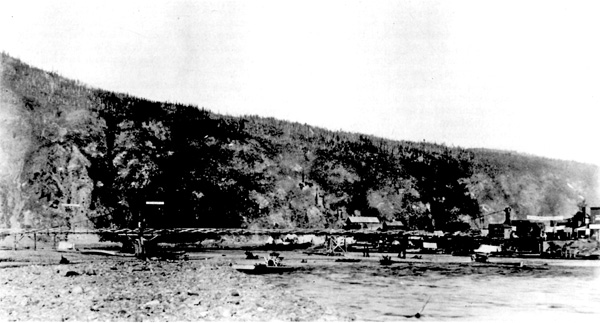
61 A suspension bridge over the Klondike River and freight scows on
both banks, Dawson, 1899.
(Yukon Archives.)
|
X
The Klondike gold rush altered irrevocably a substantial portion of
the pre-gold-rush transportation system even though that system had been
largely responsible for the scope and nature of the great stampede. Dyea
and the Chilkoot Trail, which had served almost a generation of
pre-1896 prospectors as well as the majority of those who had rushed to
the gold fields in 1897-98, virtually disappeared in the wake of
events that transpired during these years. Their demise was offset,
however, by the rise of Skagway and the White Pass route, thereby
vindicating Captain William Moore's ten-year act of faith that Skagway
would one day replace its Lynn Canal rival as the gateway to the Yukon.
For this the railroad was totally responsible.
The railroad survived as the most lasting legacy of the gold rush.
That life in the Yukon did not return to its pre-1896 state is
attributable in full to its existence. Without the railroad it is
difficult to conceive of the mining industry adapting as successfully as
it did to the conditions that prevailed after 1900 and without this
adaptation it is inconceivable how the Yukon could have sustained the
population that remained. It is inconceivable, moreover, that thousands
would have chosen to remain had they been compelled to accept eight
months of complete isolation — a fate that was theirs had the
railroad not been built.
The railroad was also responsible for the subsequent shift in trade
away from Saint Michael to the upper river and the emergence of
Whitehorse as the transportation hub of the territory. Whitehorse's
evolution to its present status was born of the decision to locate the
railroad terminus there.
Less spectacular but no less important was the need for winter
transport which the gold rush created. Before the stampede,
transportation and communication had been limited to the summer months.
This proved adequate so long as the traditional prospector and his
values prevailed, but both were overwhelmed by the great influx of
1897-98. The introduction of overland transport to satisfy this
seasonal requirement was an event of long-term significance and added
another dimension to the Yukon transportation system.
|

